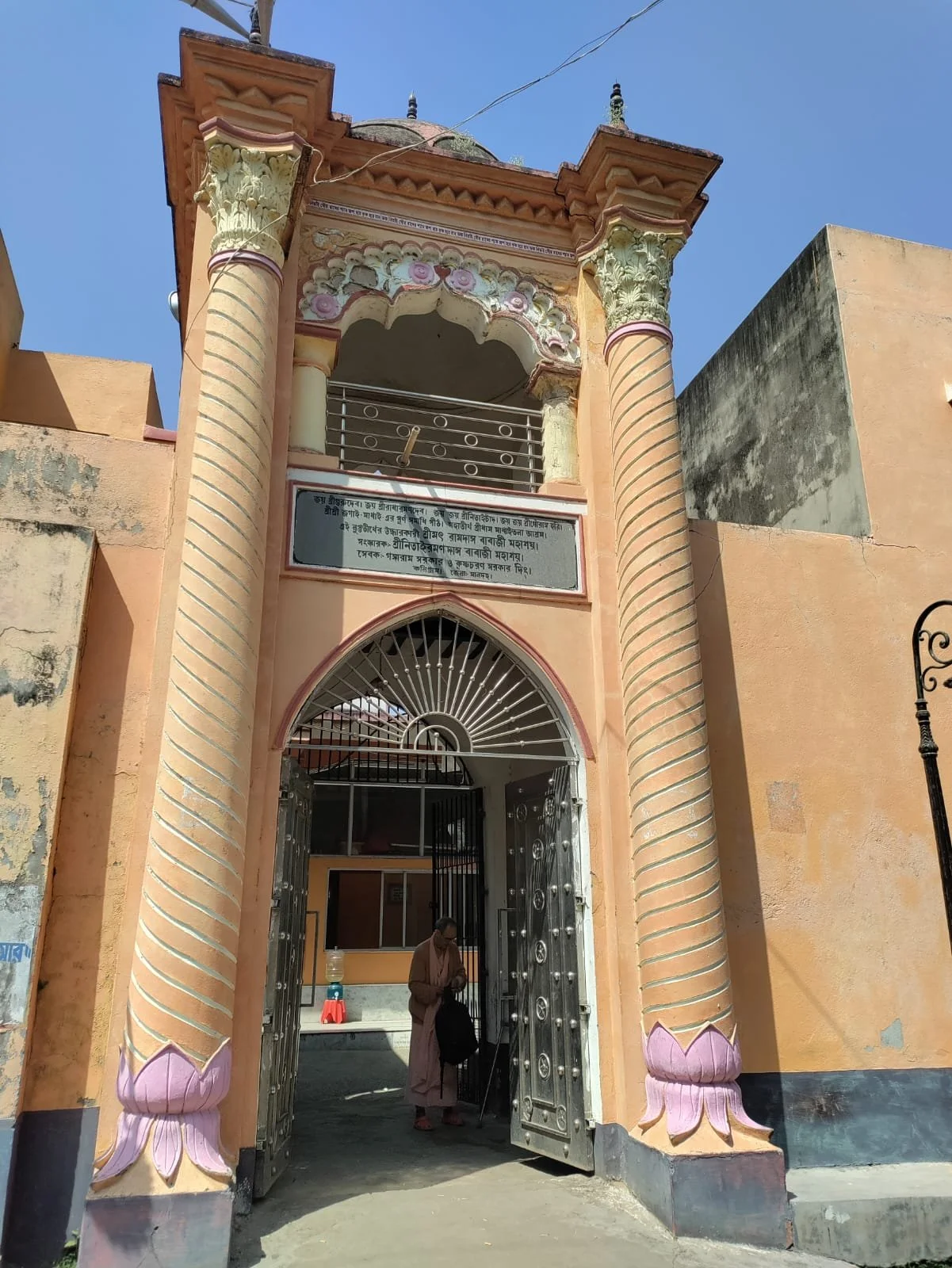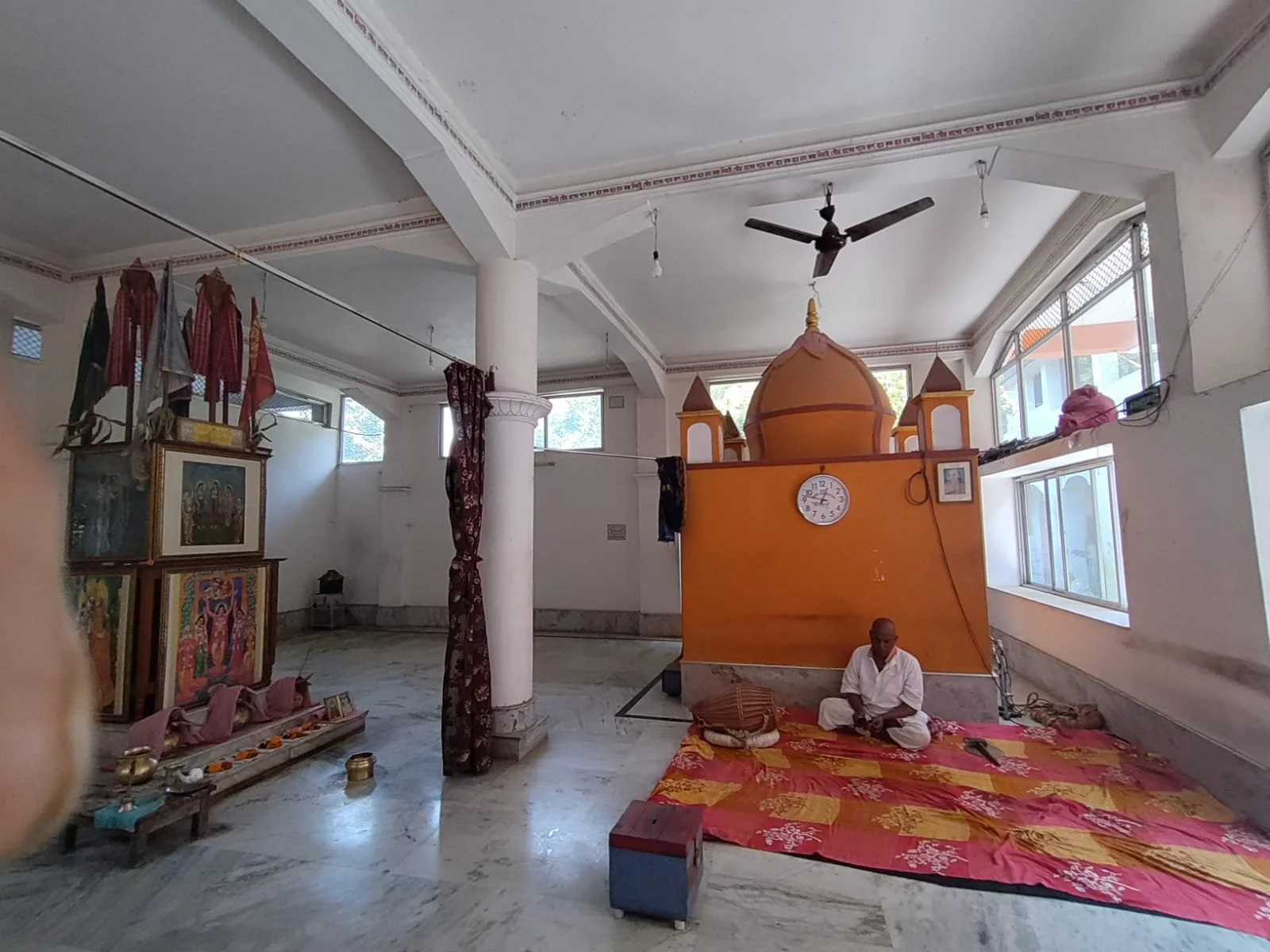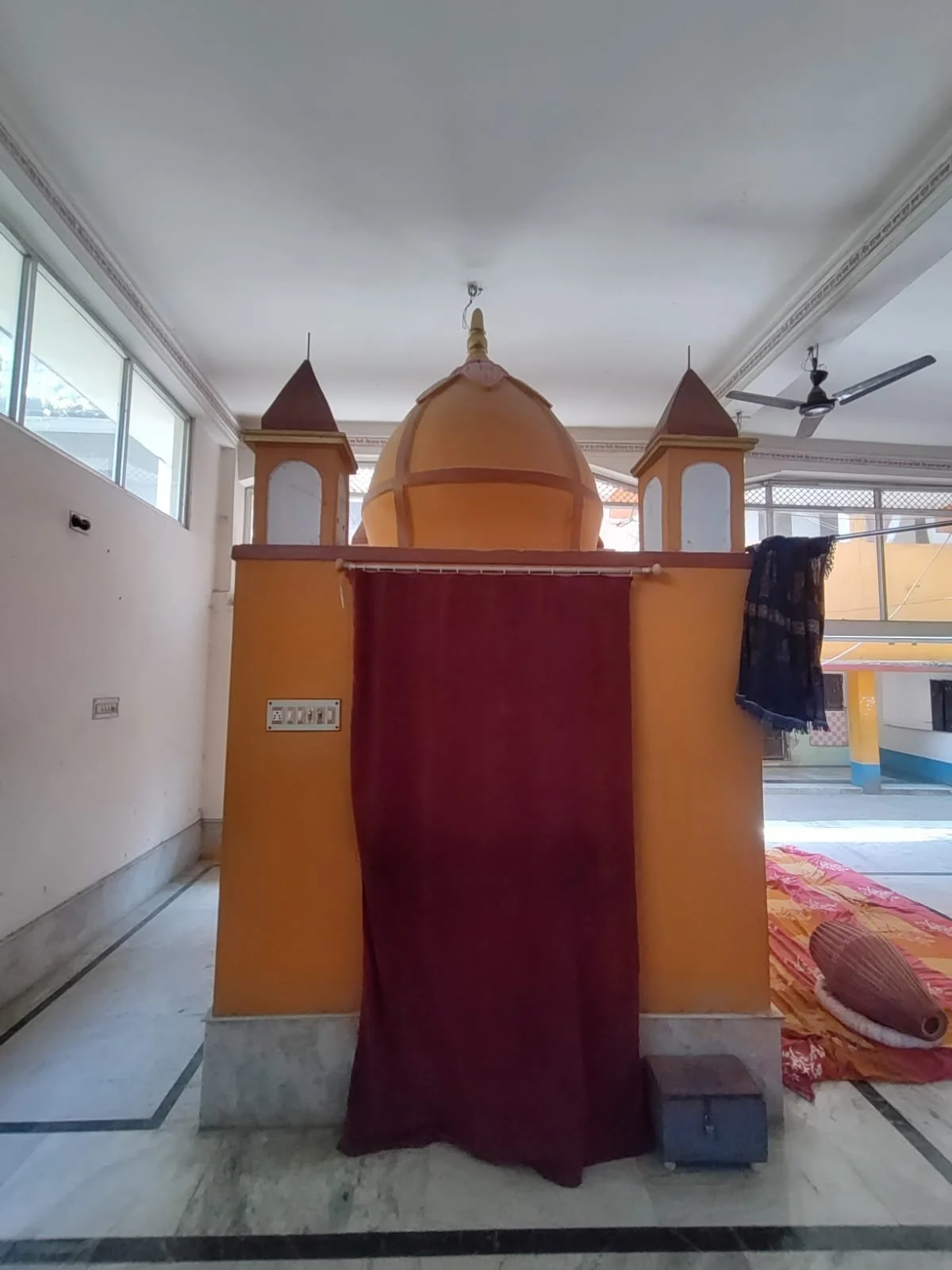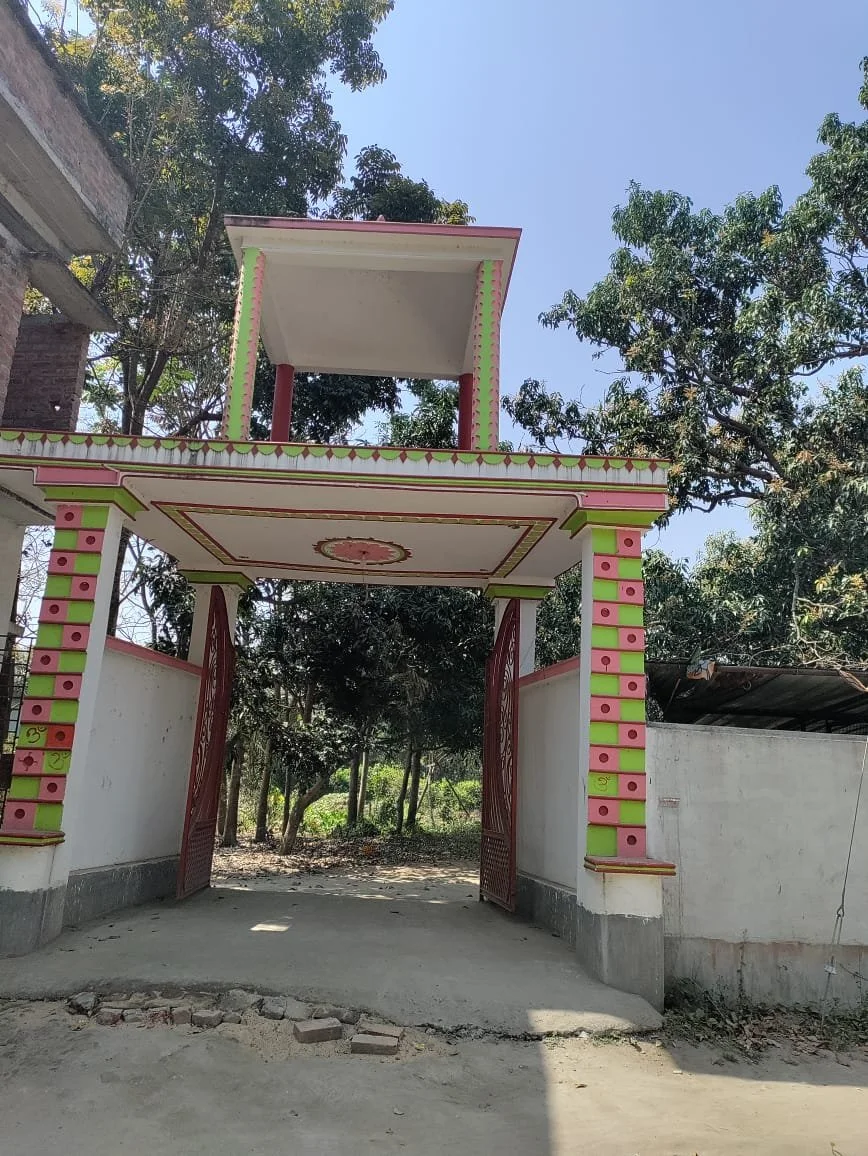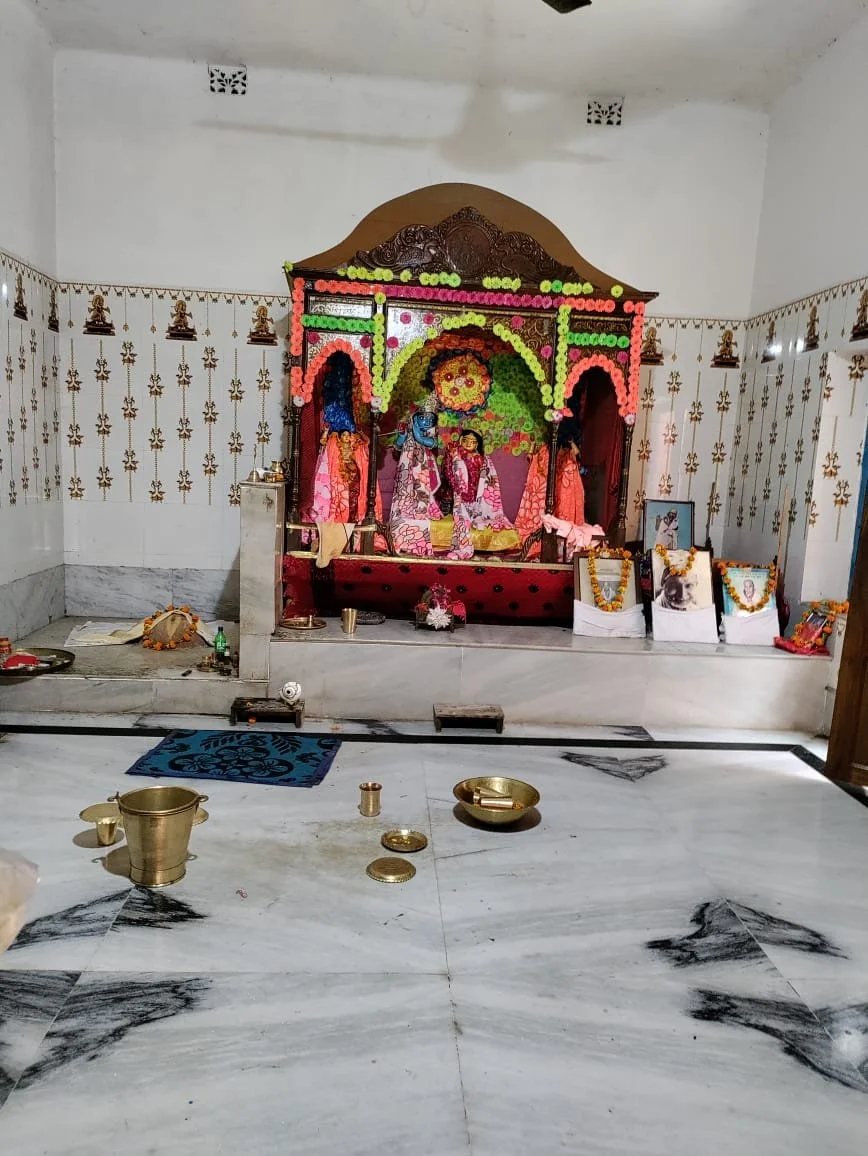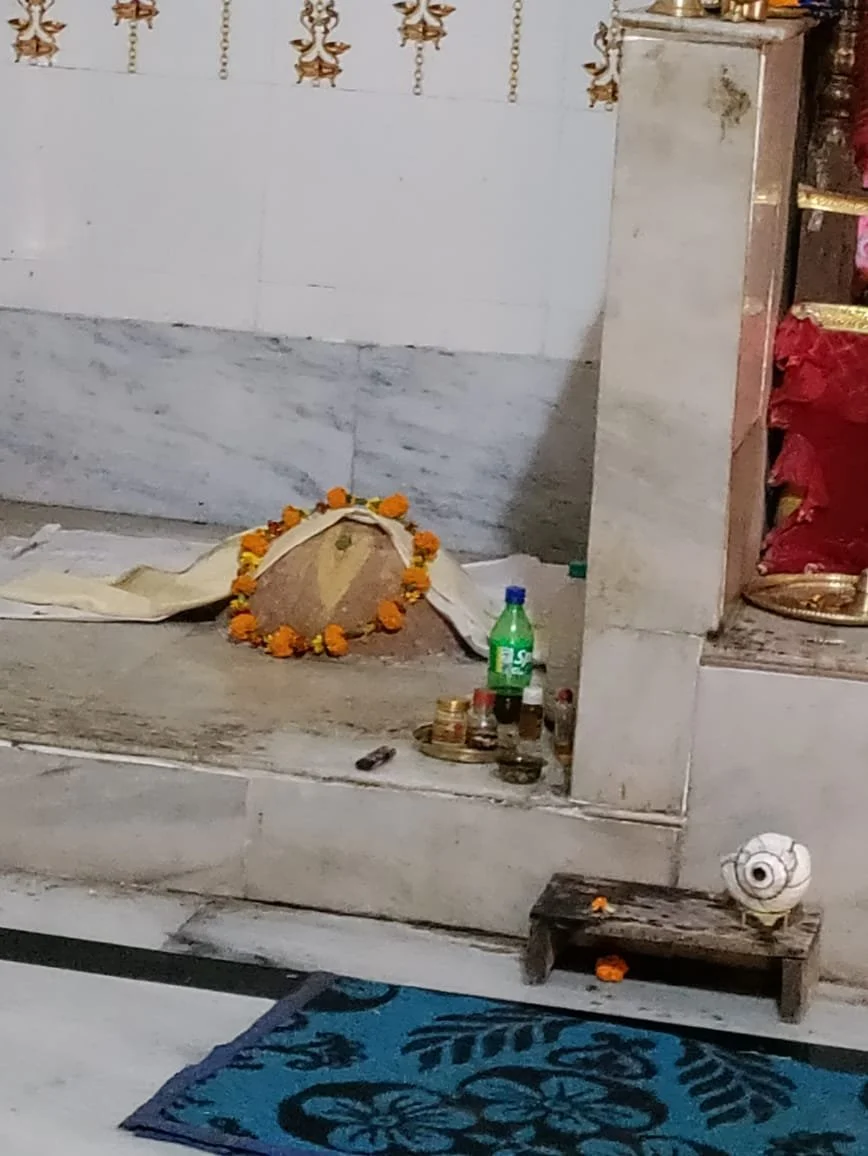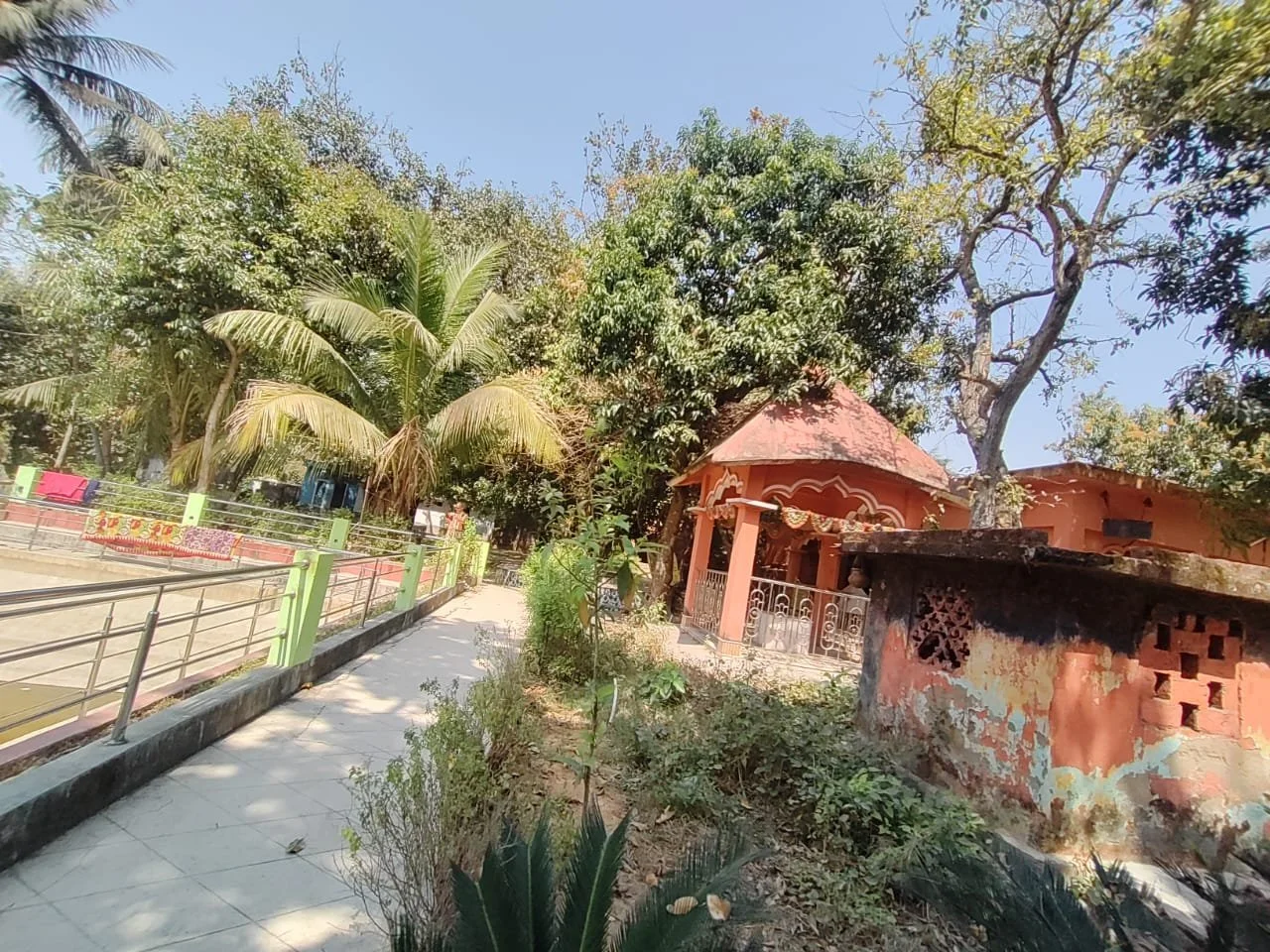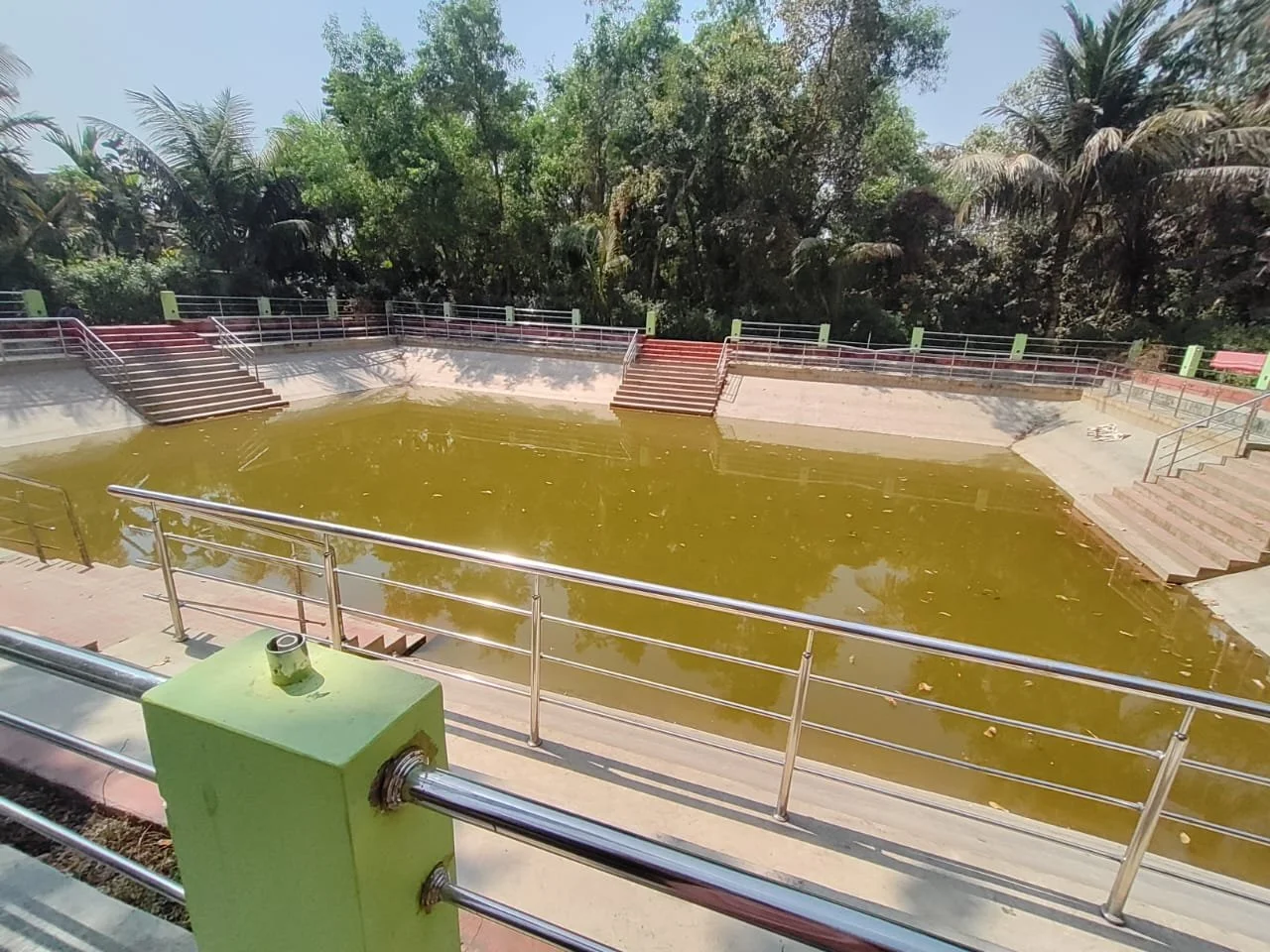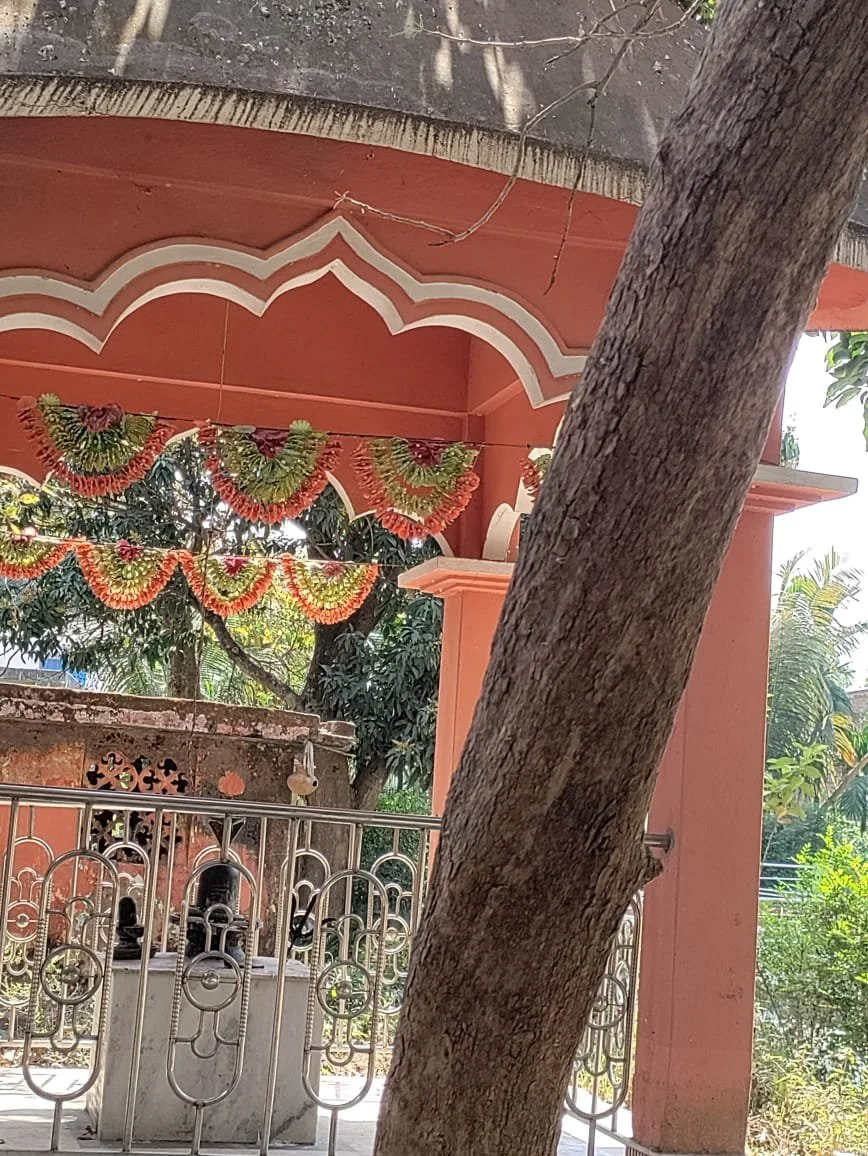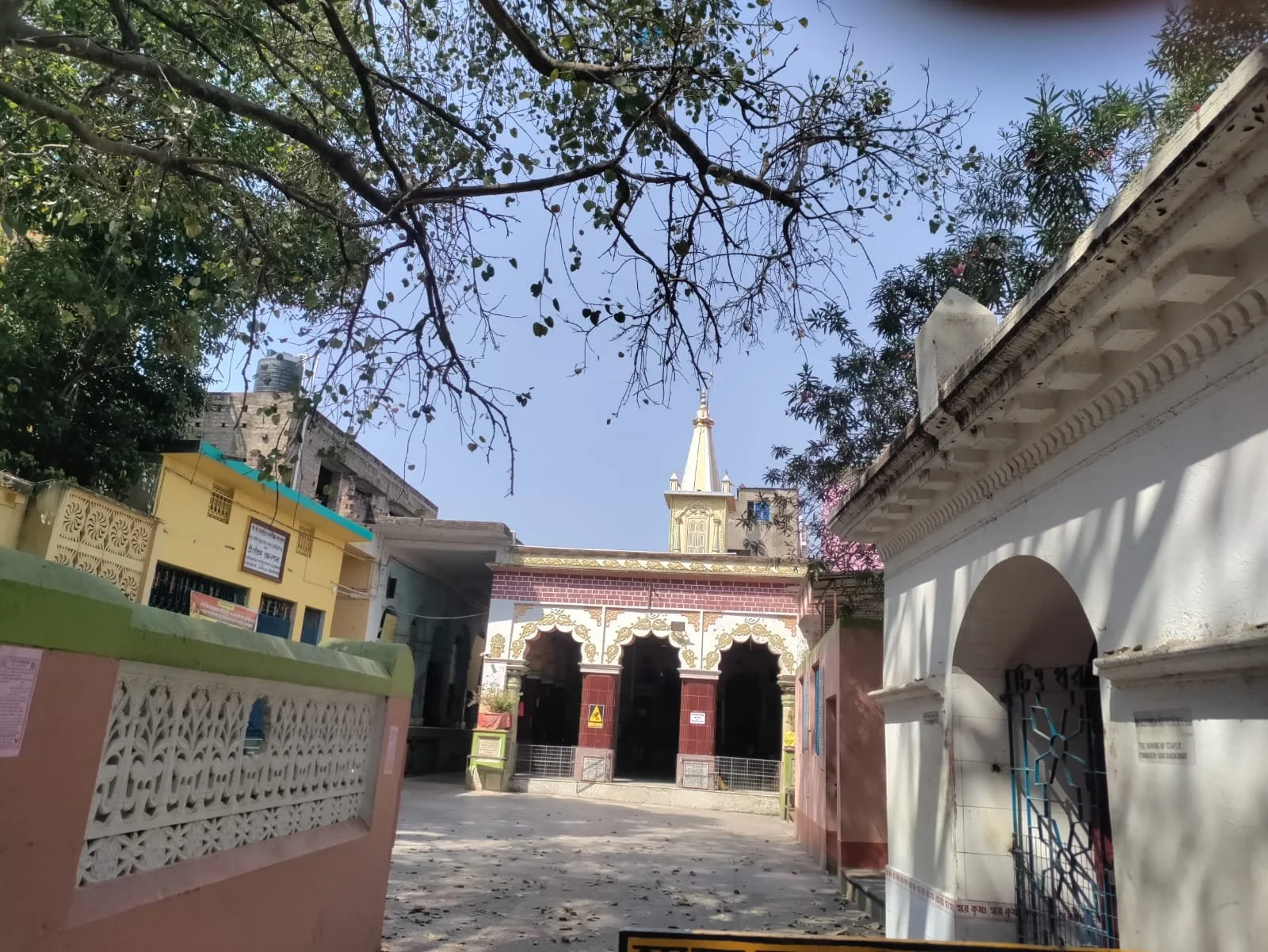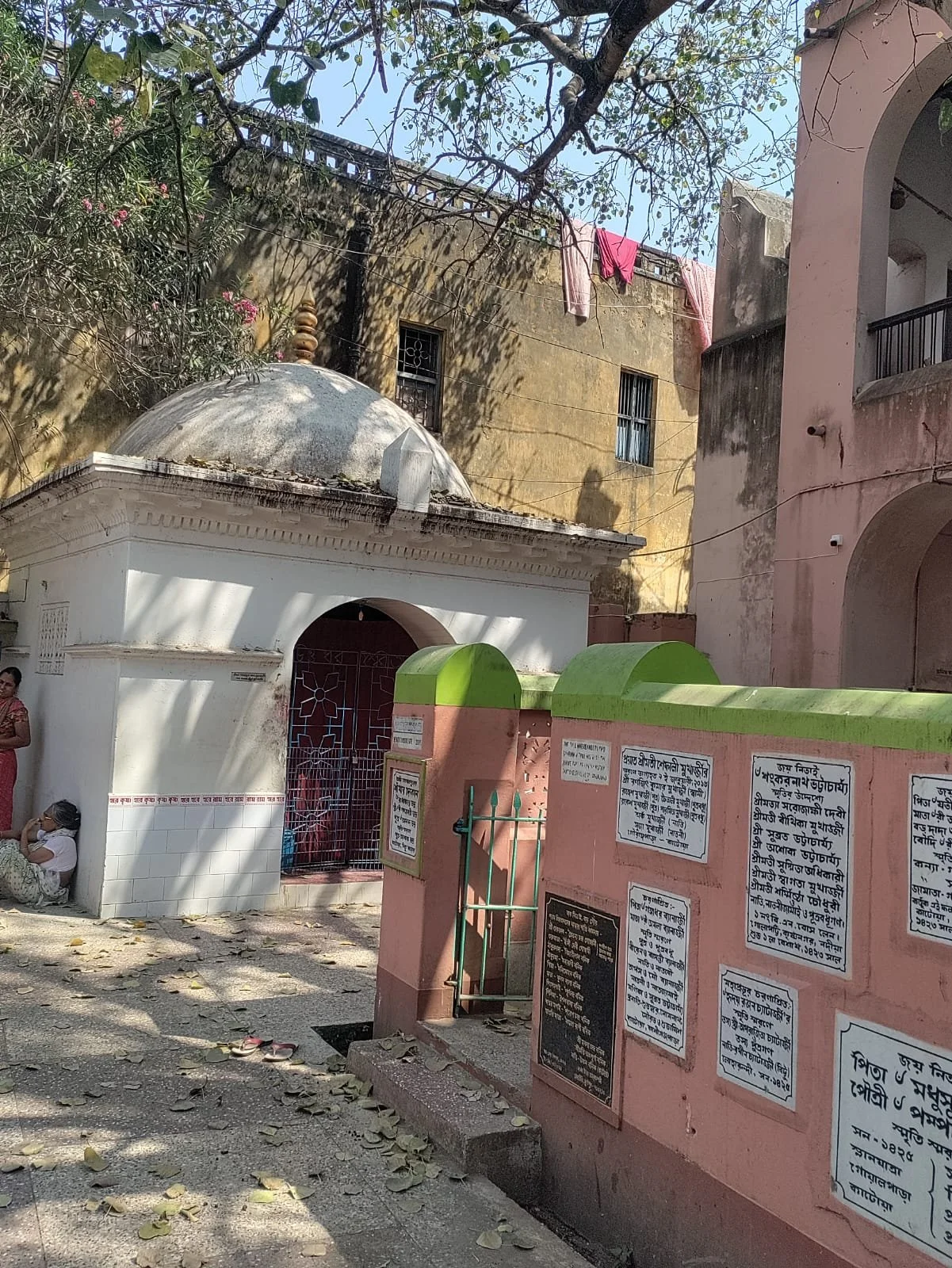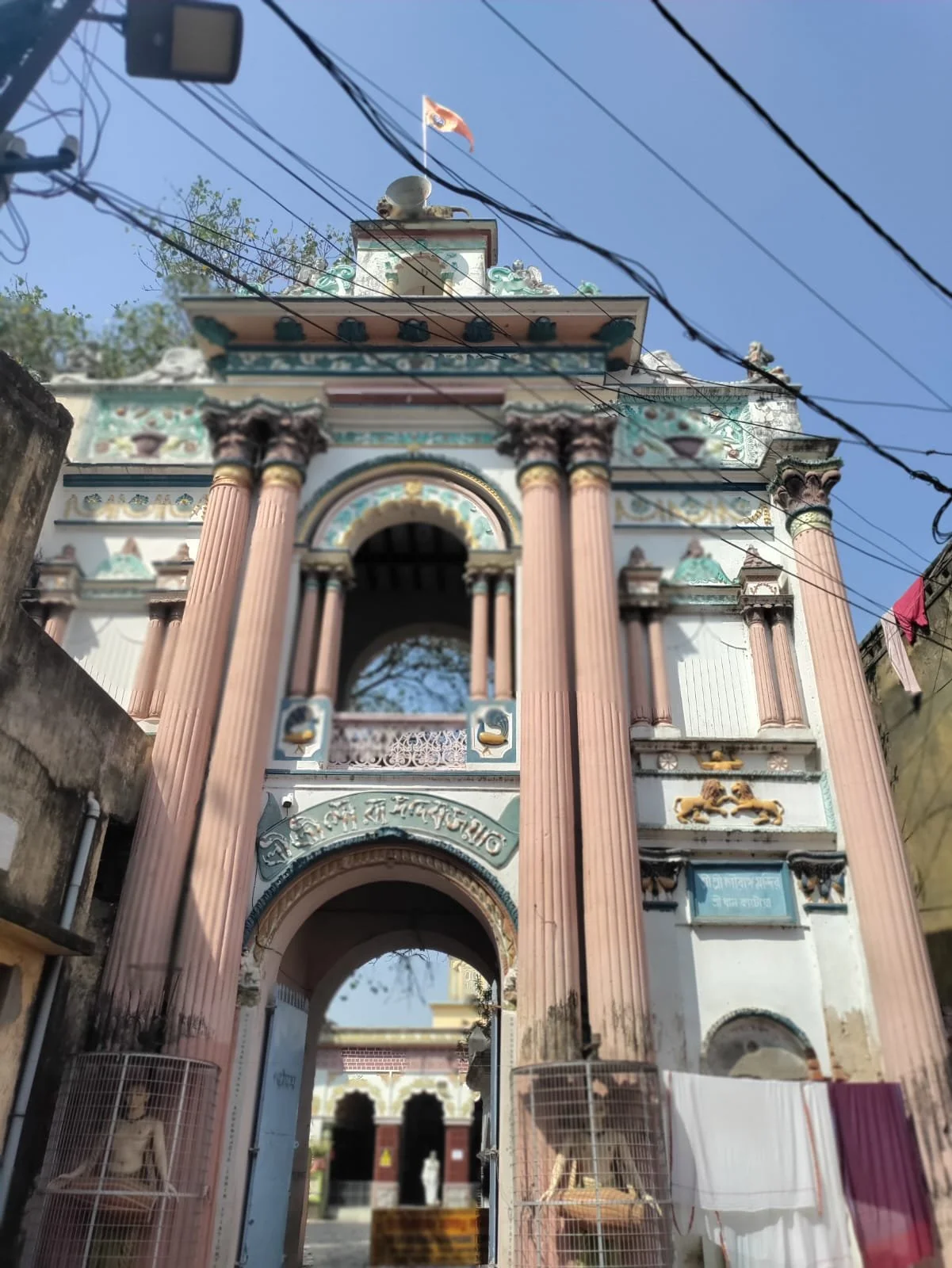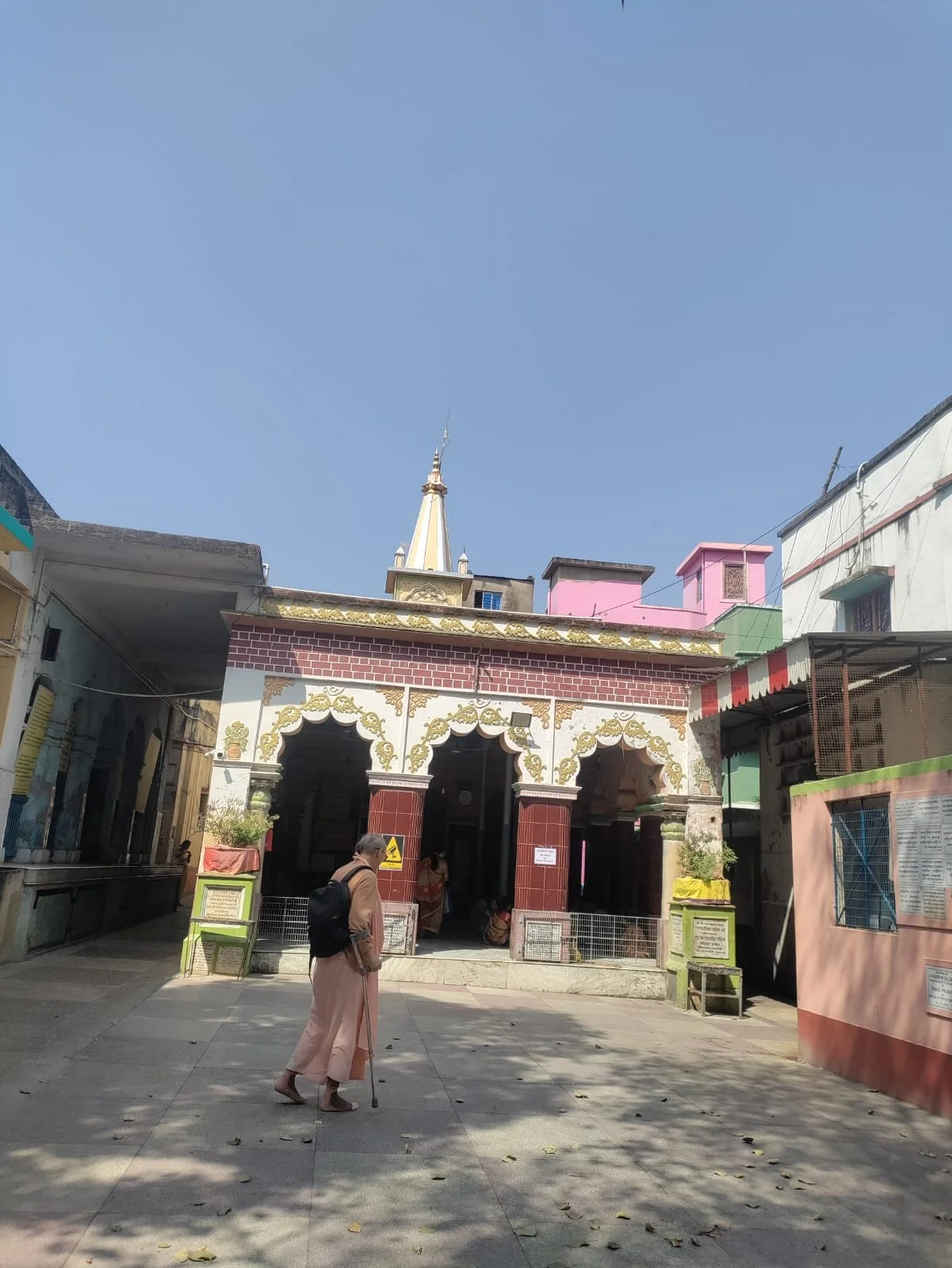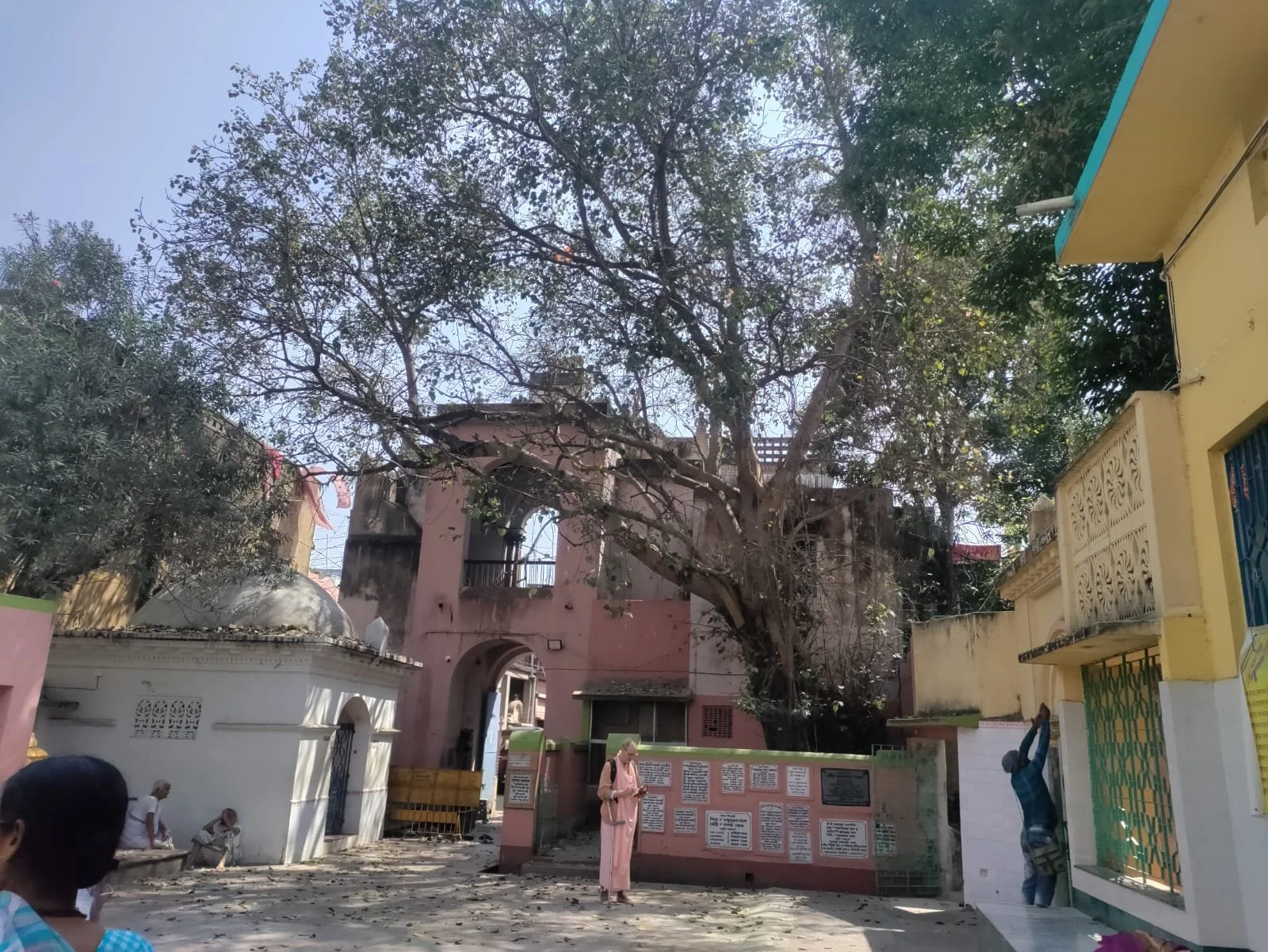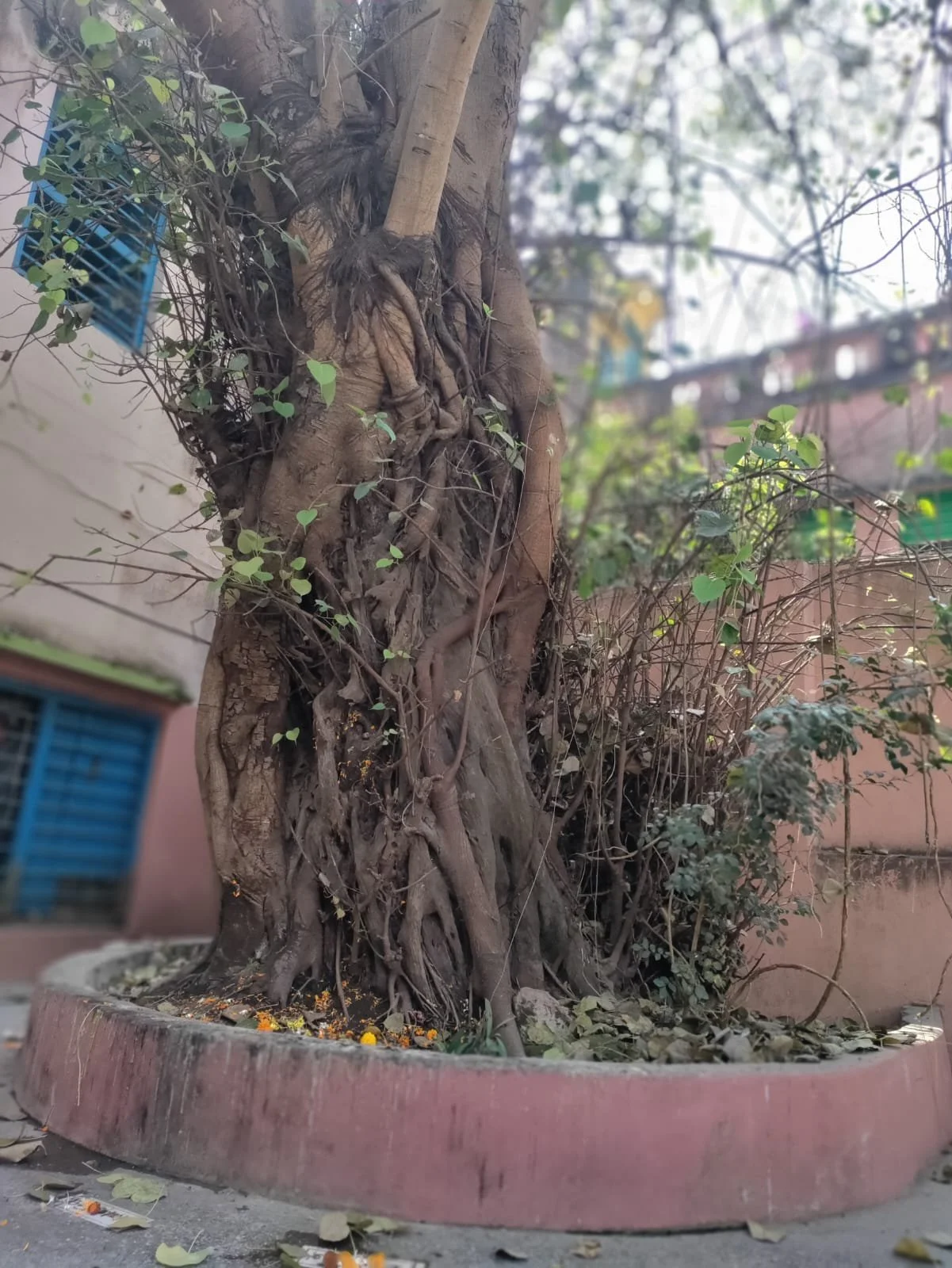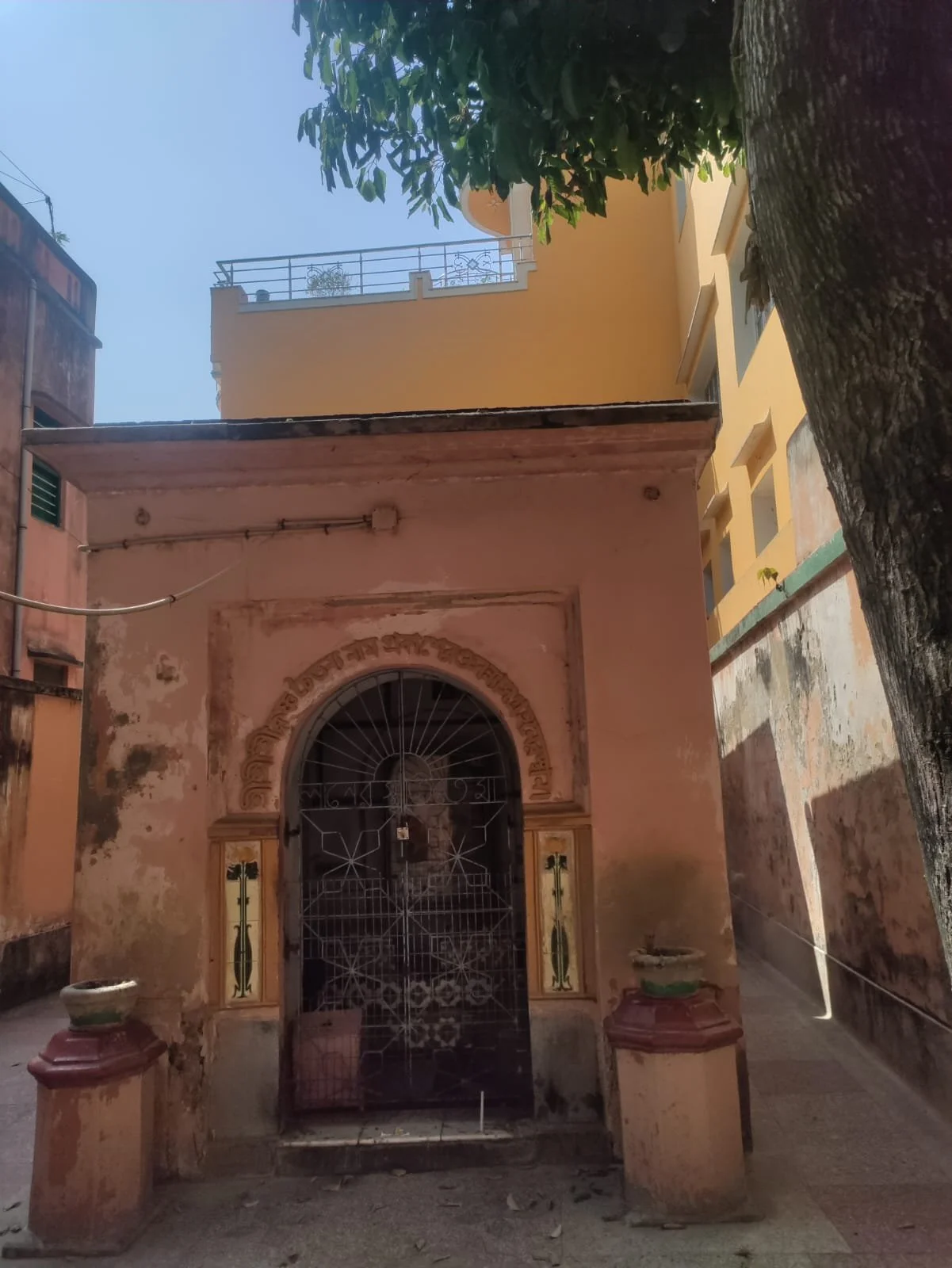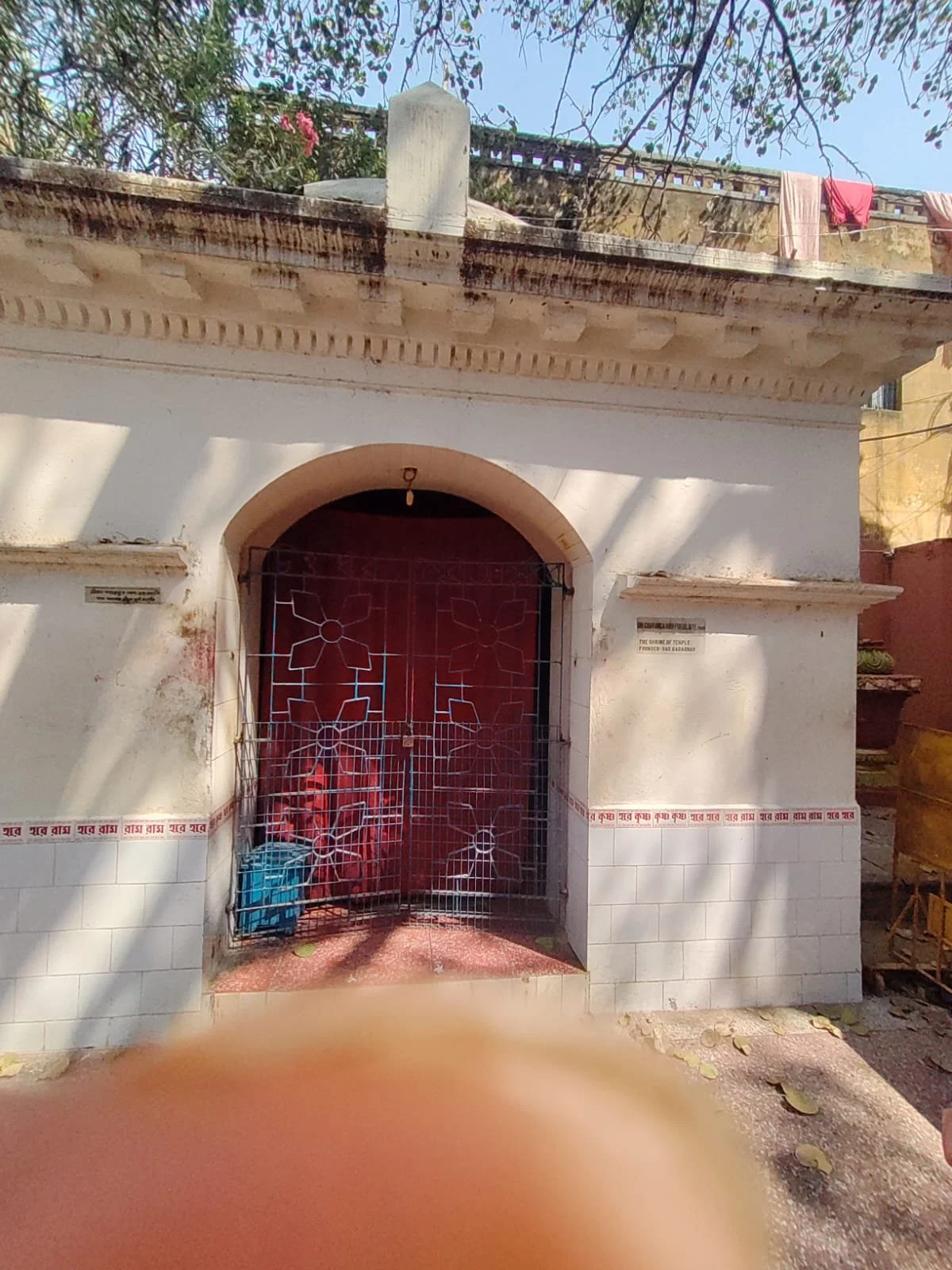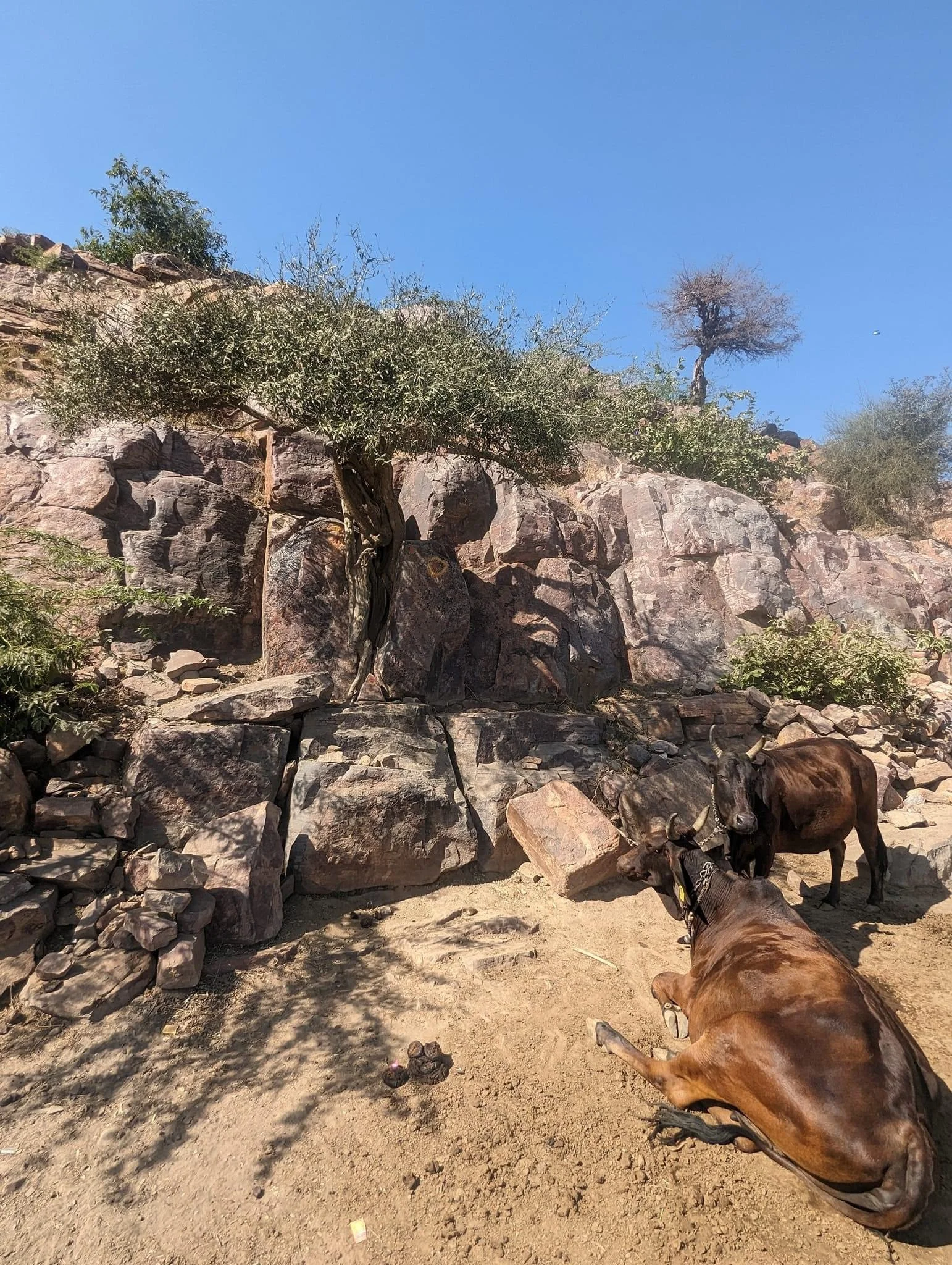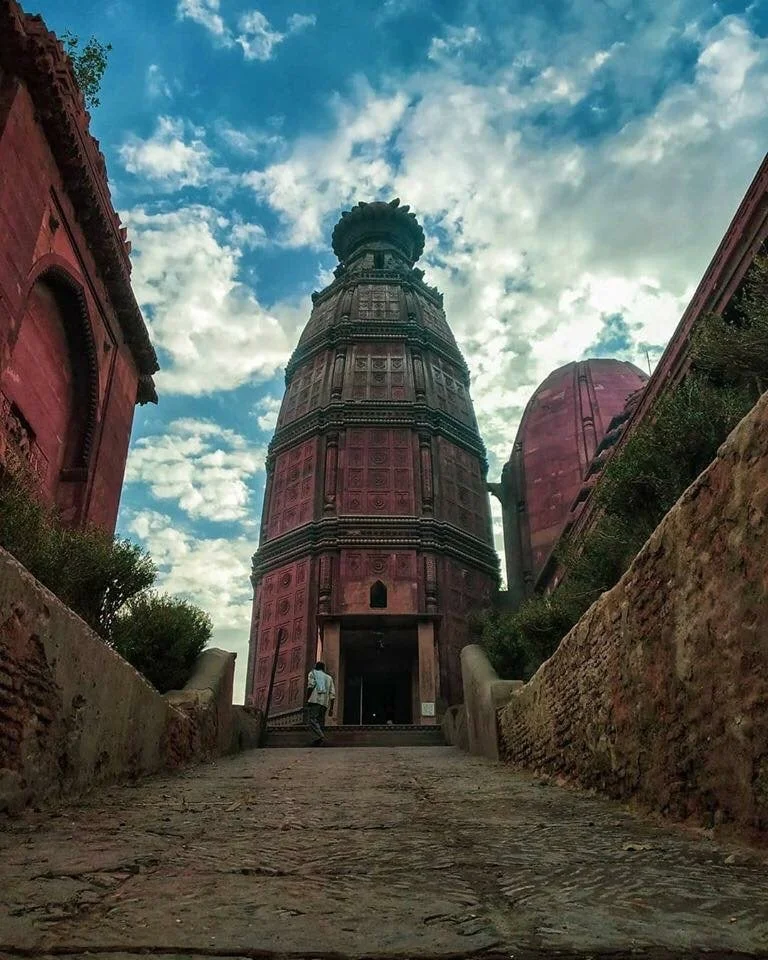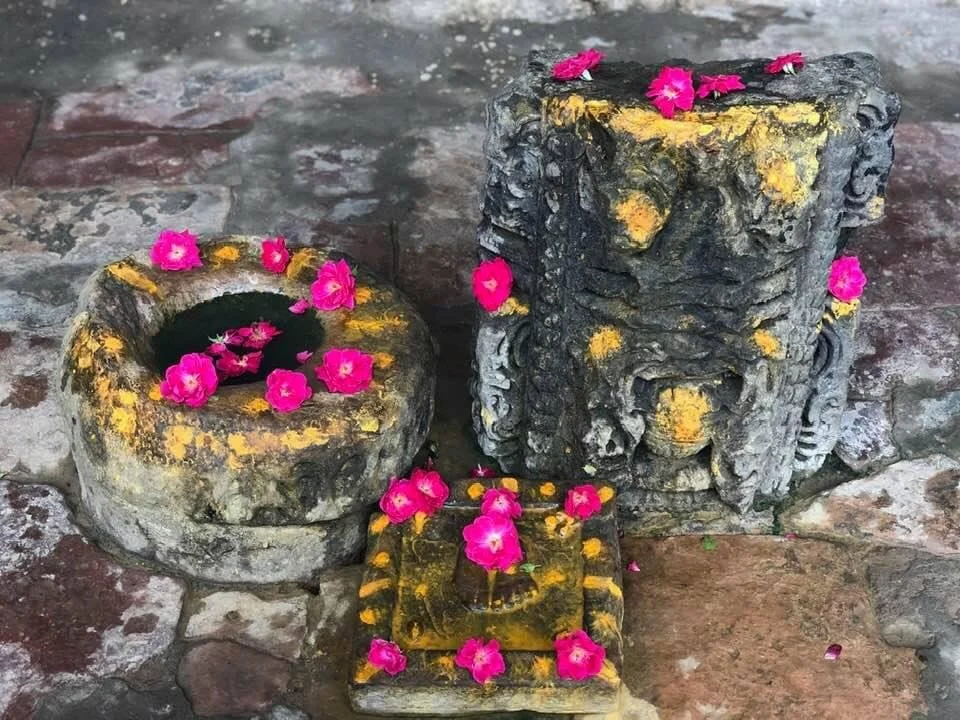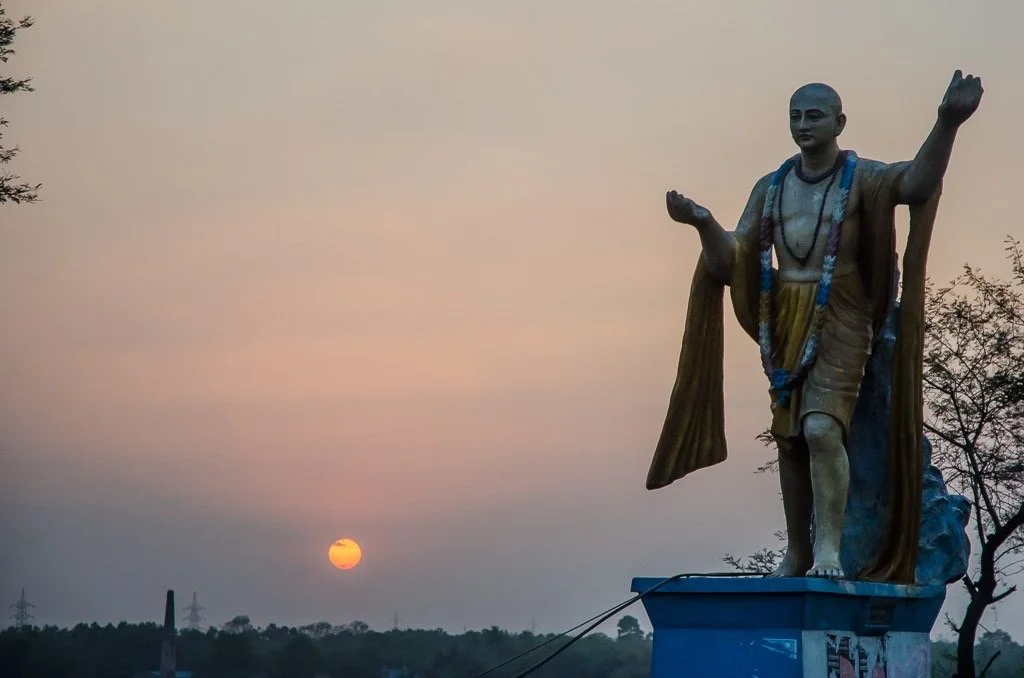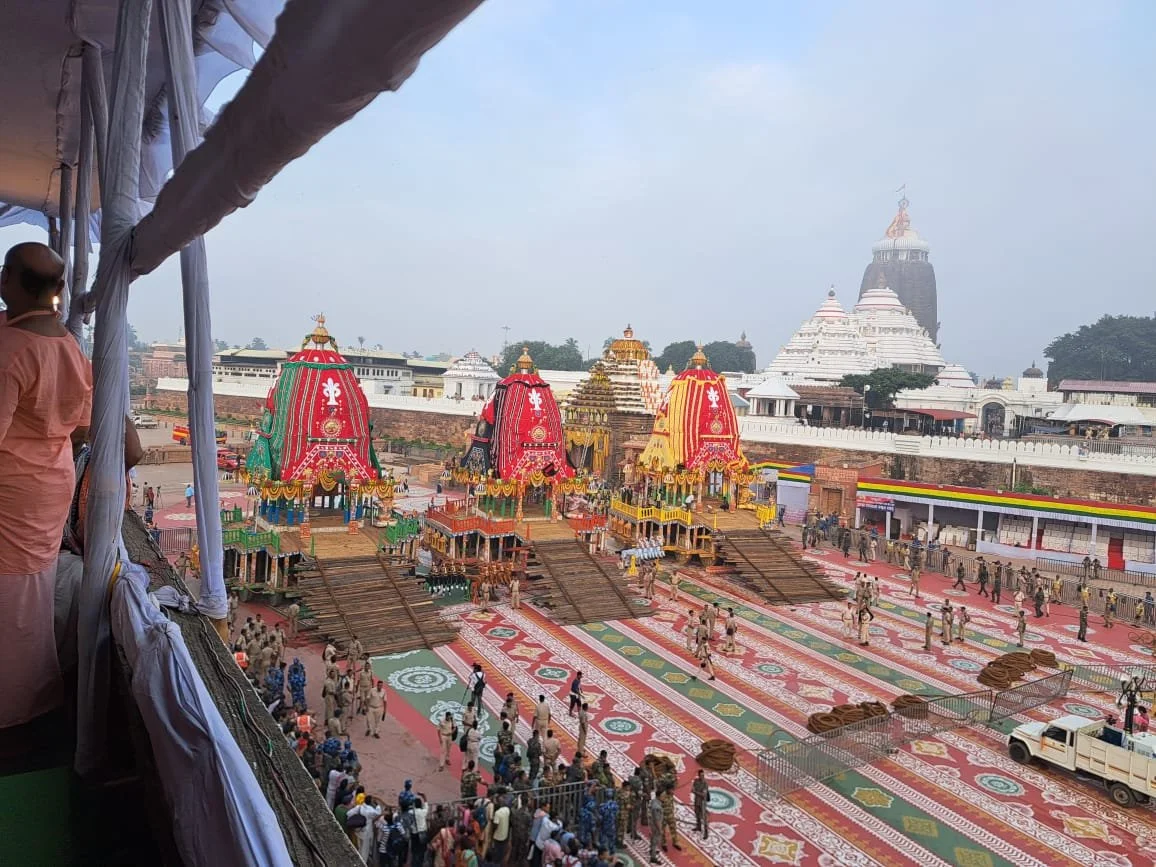
Parikrama
Parikrama: A Path of Devotion & Transformation
Parikrama, a Sanskrit term meaning “the path surrounding something,” is also known as Pradakshina, which signifies “to the right” - symbolizing the act of circumambulating a sacred place. This practice reflects the devotee’s intention to place God at the centre of their life, embodying a profound expression of devotion.
Engaging in Parikrama nurtures patience and endurance, as devotees face the elements - sun, rain, or cold - with humility. More challenging Parikramas often require relinquishing attachments to worldly comforts, helping to purify the mind. Freed from mundane thoughts, the devotee becomes fully absorbed in the presence of the Divine.
It is recommended to perform Parikrama under the guidance of a Sadhu, as they provide spiritual insight, narrate the pastimes associated with each holy place, and ensure that the devotee’s avoid causing offense in the holy dham. Their guidance deepens the spiritual experience, enriching the heart and mind with the essence of divine love.
Sri Navadwip Dham Parikrama 2025
With Sripad Bhakti Pranaya Padmanabha Maharaj
Govardhan Parikrama
-
Placed at a distance of 23 km to the west of Mathura, Govardhan hill is associated with lord Krishna.
Legend has it that lord Krishna saved the people of Braj from torrential rain by lifting this mountain as a canopy on his fingertip for seven days & nights, to vanquish the pride of the great god Indra. In the year 1520, Seth valabhacharya constructed a temple on the summit of the hill to commemorate this event.
The town is famous for its 21km long Parikrama around the holy Govardhan hill bringing eternal blessings to pilgrims. After Krishna protected the inhabitants of Braj from the wrought of Lord Indra, he commanded them to worship this pious hill.
One of the most important days of Govardhan is Guru Purnima. On this day millions of devotees, come here to perform the scared ritual of Parikrama for self-purfication.
The other attractions of Govardhan are 400 years old Har Deva ji temple, the red stone Haridev temple and the Kusum Sarovar with intricately carved Chatris of Raja Surajmal of Bharatpur. Govardhan is located in the hilly terrain of the hill known as Giriraj.
This place has bottomless tails and stories of Lord Krishna as an infant. As indicated by the Vedas, the pinnacle has dropped from the heaven itself. Legend has it that once the people of Govardhan were hit by heavy rain and the Lord himself lifted this crest for 7 sequential days and saved the lives people.
-
The total Goverdhan Parikrama distance is 21 km and takes 4 to 5 hours to complete.
This parikrama is done in two ways: the big parikrama and the small parikrama. Devotees can do this parikrama at their convenience.Govardhan Parikrama Distance
Badi Parikrama 12 km
Chhoti Parikrama 09 km
Govardhan Parikrama Total Distance 21 km
-
To complete the Govardhan Parikrama (including Chhoti and Badi Parikrama), it will take 4 to 5 hours.
Govardhan village is located in the middle of the parikrama. Radhakund village is located in the north direction and Puchhari and Jatipura villages are in the south direction.
The parikrama that starts from Govardhan Daan Ghati Mandir via Anyur, Puchhari, Jatipura and back to Govardhan is called Badi Parikrama. Which is a 12 km distance.
Then the parikrama from Govardhan via Uddhav Kund, Radhakund
Shyamkund, Kusum Sarovar and Mansi Ganga and coming back to
Govardhan is called Chhoti Parikrama. Which is a 9 km distance
-
You need to know the rules of performing Govardhan Parikrama.
Before starting the Parikrama of Govardhan, first offer respects to Mount Govardhan and end the Parikrama at the same place from where you started.
It is believed that whoever wants to start the parikrama must take a bath in the Mansi Ganga.
Also, keep in mind that you should never leave the parikrama incomplete in the middle.
-
Usually, visitors do the parikrama barefoot so it can be done during the daytime in December to March and April to November in the nighttime. As the temperature increases in Uttar Pradesh during summer.
-
Govardhan Parikrama
(going 21 kilometers around the way) is a sacred custom performed by numerous devotees as spiritual purification. There are no time restrictions for performing out dandabat Parikrama, for those who perform the Parikrama it may take weeks and sometimes even months to complete. This sacred custom of Parikrama is considered
Mansi Ganga Kunda
considerably littler throughout the years. It is believed that Radharani and Krishna would go boating on this lake. This tank denotes the beginning and ending purposes of the sacred Govardhan Parikrama. It bears relations to Lord Krishna. It was built by Raja Bhagwan Das and Raja Man Singh. It is recognized as the holiest of the kunds. Devotees here trust that a plunge in this sacred Mansi Ganga Kunda would take away every one of their transgressions and sins.
Daan-Ghati Mandir
There is a mischievous story of Lord Krishna and Radha Ji associated with Daan-Ghati Mandir. A toll must be paid in order to pass this place. At the time of Krishna's, Krishna was a toll-gatherer and performed dan-Lila, or a paid toll activity, with the gopis through cherishing squabbles and mockery.
Radha Kund & Shyam Kund
Radha Kund and Shyam kund are two pious ponds situated in a village named Arita near Govardhan hill. 3 miles away in the northeast of Govardhan hill these two kunds are considered as the most sacred place for the Vaishnavas. Believed to be eyes of Govardhan hill, this place has witnessed many sweet pastimes of Lord Krishna and Radha.
Braj is associated to Lord Krishna’s leela and every place in the Braj has its own significance and attachment with Lord Krishna, these kunds are one such place and is associated to Krishna in a very special way. It holds a very special place in Krishna devotee’s heart.
Purest place in the world:
According to the legends, Krishna was to kill his uncles Kans in lieu of all the sins done by the latter in Mathura. To keep himself safe, Kans used to send demons to kill Krishna. One such demon was Arishta who came in the disguise of a bull and was killed by Lord Krishna and Balaram who easily overpowered the evil and saved his friends from this demon. When Krishna after killing this dangerous demon went to meet Radha rani she jokingly refused to play with him and asked him to take bath in every holy place and then touch her pure body. Lord Krishna then created a kunda by striking his heel on the ground and summoned all the holy places to enter the Kunda in the form of water. Krishna then bathed in it and teased Radha rani that he is perfect in creating such pond. Radha Rani also wanted to dig a pond for her and did it with her bracelet. When not even a single drop of water was manifested in the kunda Shri Krishna signaled all the holy places to again enter in Shri Radha Rani’s Kunda in the water form.
Radha Kunda (well) is known to be the holy bathing spot of Radharani. She had reprimanded Krishna, saying that he became impure by slaughtering a bull, by the symbol of religion. She proposed that he could purge himself by scrubbing down in every sacred stream. As opposed to going to every consecrated place, he hit the ground with his foot rear area and water from every blessed waterway showered up. The place was then known as Shyama-Kunda. In a focused state of mind, the Gopis drove by Radharani additionally made a Kunda by burrowing the earth with their bangles. Hence, Radha Kunda showed up.
Kusum Sarovar
Kusuma Sarovara, an excellent sandstone landmark, is a 25-minute stroll from Radha Kunda. Kusuma signifies "flower," and here the gopis would pick blossoms for Krishna. Kusuma Sarovara serves as the best swimming spot in Braja. The ghatas at this kunda and the structures over the Kunda were built by Jawahir Singh, the lord of Bharatpur around 1764, out of appreciation for his dad Raja Suraj Mall. There are excellent works of art on the roof of three tombs, to be specific the principal tomb of Raja Suraj Mall and other toms of those of two queens, Kishori and Hansiya. There is additionally a Giriraja Temple here.
-
Vrindavan Parikrama
-
Vrindavan is the most famous religious place of Brajmandal. It is the heart of Vrindavan Bridge. It has been a witness to the indescribable divine pastimes of Shri Radha Krishna. Vrindavan, located at a distance of 12 km from Mathura, has about 4000 temples, ghats and lakes
It is a customary practice for devotees and pilgrims visiting Vrindavan to walk around the town along the parikrama path. The distance of the parikrama is around 15 kilometres and great religious importance is attached to undertaking this on Ekadasi day (the eleventh day of the waxing-waning moon). By walking barefoot along the parikrama path, which takes about three to four hours, it is believed that one receives blessings from the sanctity of the locations.
The Parikrama encompasses twelve vanas (forests) and twenty four upavanas (groves). The twelve vanas are Bahulavan, Belvan, Bhadravan, Bhandiravan, Kamavan, Khadiravan, Kumudvan, Lohavan, Mahavan, Madhuvan, Talavan and Vrindavan. Adibadri, Ajnokh, Aring, Barsana, Bacchavan, Bilchhu, Dadhigram, Gandharvavan, Gokul, Govardhan, Karahla, Kelvan, Kokilavan, Kotvan, Mat, Nandgram, Parsoli, Paramadra, Pisaya, Raval, Sanket, Sessai, Srikund and Uchagram are the twenty four upavanas. The vanas and upavanas together comprise the sacred places and sites that witnessed the life and events of Shri Krishna.Some of the significant temples, vanas and ghats that roughly form the periphery and are visited on the Parikrama are:
Krishna Balarama Mandir
Gautama Rishi’s Ashram
Varaha Ghat
Mohana Ter
Kaliya Ghat
Madon Mohan Temple
Imli Tala
Sringara Vat
Keshi Ghat
Tekari Rani temple
Jagannath Temple, with deities of Jagannath, Balarama and Subhadra
Chaitanya Mahaprabhu temple
Along the path of the Parikrama are many other temples and idols, some of which are in broken down condition from the days of the Mughal onslaught.
-
15 Km
-
Embarking on Vrindavan Parikrama Marg requires mindful preparation. Visitors should wear respectful attire, such as traditional clothing, and carry essentials like water, comfortable footwear, and sun protection. A small bag for offerings and a camera to capture the spiritual journey can be beneficial. Equally crucial is mental preparation, fostering a receptive mindset for a spiritually enriching journey amidst the sacred landmarks. These tips ensure a meaningful and respectful engagement with the divine essence of Vrindavan's spiritual heritage
-
The optimal time for Vrindavan Parikrama is during spring and autumn, characterized by moderate temperatures. Festivals like Holi and Diwali enhance the spiritual experience. Devotees should consider weather conditions, avoiding extreme heat or heavy rainfall for a more comfortable and meaningful pilgrimage.
-
RADHA DAMODAR TEMPLE
This is one of the most important of the ‘Seven Goswami Temples’ and was established by Srila Jiva Goswami, who was both the nephew and the disciple of Srila Rupa Goswami.
The original deity of Radha Damodara was personally hand carved by Rupa Goswami and given to Jiva as a gift. This deity is now being worshiped in jaipur, where all the deities of the Gaudiya Goswamis were taken for safety due to the fear they would be desecrated by Aurangzeb’s soldiers.
The replica deity known as the pratibhu-murti, which has exactly the same potency as the original, is presently being worshiped here at the Radha Damodara Mandira. (Ref VMP) The contemporary Gosvāmīs and devotees assembled here for iṣṭagoṣṭhīs and, in those gatherings of Vaiṣṇavas, Śrī Raghunātha Bhaṭṭa would elucidate on Śrīmad-Bhāgavatam in his melodious voice. Śrī Rūpa Gosvāmī compiled Śrī Bhakti-rasāmṛta-sindhu, Ujjvala-nīlamaṇi and other sacred texts on bhakti at this place.(Ref VMP). Between the two buildings and just next to the parikrama path is a well that represents the one commissioned by Rupa Gosvami and used to serve Radha-Damodara until Srila Prabhupada’s time.
RADHA GOKULANANDA TEMPLE
The temple of Radha Gokulananda is one of the ‘Seven Goswami Temples’ of Vrindavana and was established by Lokanatha Goswami.
This temple was established by Lokanatha Goswami, who in the later years of his life performed bhajan at this place. Although he was not one of the Six Goswamis, he was one of the renowned Gaudiya Goswamis and his temple is included amongst the famous ‘Seven Goswami Temples’. Lokanatha is often referred to as being the ‘Seventh Goswami’ of Vrindavana.Although the temple he founded was known as Radha Gokulananda, he himself worshiped the deity named Shri Shri Radha Vinoda, which he discovered in Kishori-kunda at Umraya.
RADHA GOPINATH TEMPLE
The deity of Lord Gopinatha was originally established by Vajranabha Maharaja at Vamsi Vata five thousand years earlier. Then during the period of the Six Goswamis the deity of Lord Gopinatha was rediscovered at Vamsi Vata lying buried in the ground near the famous banyan tree. Madhu Pandita Goswami came to Vrindavana and was searching everywhere for the deity of Lord Gopinatha.
Not finding the deity anywhere, and feeling great sorrow, Madhu Pandita gave up eating food and sat at Vamsi Vata while shedding a constant stream of tears. As it was the monsoon season there was a great flood in Vrindavana and the River Yamuna overflowed her banks. The force of the flood waters apparently swept away the old banyan tree that stood at Vamsi Vata and when the flood waters receded, the deity was seen halfburied in the ground by Madhu Pandita’s close friend and companion named Paramananda Bhattacharya, just beneath where the old banyan tree had once stood.
Paramananda immediately called his friend Madhu Pandita who retrieved the deity. The deity was then moved to the spot where the present Gopinatha temple now stands.
Gopinatha Ji Temple in Vrindavan is one of the most popular and ancient temples of Vrindavan. This beautifully constructed temple is approximately 5000-year-old and the present deities were installed after the Mughal invasion. Due to the same invasion, the old idol of Lord Krishna in the temple was shifted to Jaipur.
Gopinatha Ji Mandir in Vrindavan is thronged with a huge number of visitors. The sacred environment of Gopinatha mandir is so pious and the temple was destroyed by Aurangzeb. Being amongst the many temples that subsided to Aurangzeb’s destruction, Gopinath Temple in Vrindavan was reconstructed with immense devotion again in the year 1812 AD. In a nutshell, the temple has been evident to the ups and downs of both Vrindavan and India’s historical saga.
Gopinath Temple in Vrindavan or Gopinath Ji is the most worshipped amongst local residents as well. It is believed that the idol seated in the temple is miraculous and fulfills every wish of the devotee visiting the temple. The deity now worshipped in Gopinath mandir is of Murlidhar Mahaprabhu, or Lord Krishna playing the flute. Sri krishna stands with ananga-manjari to his left and Radha Ji on his right. Laita and Vishakha accompany them on both sides. To attain salvation and to feel the piousness of being in Vrindavan pilgrims must visit Gopinath Mandir also known as the Radha Gopinath Temple of Vrindavan at least once in their life-time.
RADHA SHYAMSUNDAR TEMPLE
The temple of Radha Shyamasundara is one of the ‘Seven Goswami Temples’ of Vrindavana and was established by Shyamananda Pandita Goswami during the course of his second visit to Vrindavana.
Although he was not one of the Six Go swamis of Vrindavana, he is counted amongst the famous Gaudiya Goswamis who were important followers of Lord Chaitanya Mahaprabhu. Like Radha Damodar, the exterior of Radha Shyamsundar Temple is very modest. The courtyard is a bit larger than Radha Damodar’s, and instead of three arches, the altar has five. Tulasi grows in the courtyard and the samadhi of Shyamananda Prabhu is nearby.
Most of his disciples were from Jagannatha Puri, Orissa, evident by the plaques in Oriyan script bearing the names of temple donors.(Ref VD) Çré Baladeva Vidyäbhushan up on establishing Gaudiya Vaishnavism as a sampradaya in its own right was awarded the stewardship of Radha-Syamasundara’s temple, a service that he performed up to his last breath.
RADHA RAMAN TEMPLE
Significance of worshiping Shalagrama-shila:
This is one of the ‘Seven Goswarni Temples’ and was established by Gopala Bhatta Goswami, one of the famous Six Goswamis of Vrindavana. The deity of Radharamana suddenly self-manifested one day from a shalagrama-shila just for the pleasure of Gopala Bhatta. All shalagrama-shilas are considered to be a natural manifestation of Lord Vishnu and are therefore immediately worshipable and do not need to be installed.The shalagrama-shila is a sacred black stone that is worshiped specifically by brahmanas and must be worshiped in all Vedic sacrifices as the yajna-pati, or principle enjoyer of the sacrifice. The shalagram-shila is also an essential part of deity worship being the principle recipient of the seva-puja, and no worship is considered complete without the shaligrama-shila being worshiped as the seva-pati
Temple construction:
Radha Ramana is only a short walk, on route to Kesi Ghat. We enter the temple compound through an archway leading in from the street. The new temple building for Radha Ramana was completed in 1826 by Shah Kundan Lal, the same architect who built Shahji Temple.Temple Architecture:
Two-story buildings enclose the first courtyard, shutting out direct sunlight. We enter a second courtyard and behold the Radha Ramana Temple wedged in between a couple of buildings. The facade is built of light brown sandstone, and the main archway is decorated with spiraling lotus designs.RADHA GOVINDADEVA TEMPLE
Sri-Sri Radha Govinda at Yoga-pitha are the main Deities of the Gaudiya Vaisnava Sampradaya, because they accept the devotee’s service and inspire ever-increasing surrender and loving devotion. Yoga-pitha means the meeting place or the place where a devotee can connect with Krishna and His eternal associates. The means of connection is surrendered devotional service for the pleasure of Lord Govinda, as most perfectly exemplified in the selfless actions of Srimati Radharani and the gopis.
While reading the following description of the beauty of Radha-Govinda’s Yoga-pitha, one should not forget the goal of completely dedicating himself to the loving service of the lotus feet of Sri Guru, Sri Gauranga and Sri-Sri Radha-Govinda. Actually, the Yoga-pitha means service; for the service attitude permeates everything there. The ground, the trees, the flowers, the vines, the fruits, the deer, the birds, the jewel-cottages, the wind, the Yamuna, the manjaris, the gopis and Sri Radhika everything and everyone within the Yoga-pitha exists only for the service and pleasure of Sri Govinda. At a distance of 1 km from Vrindavan Railway Station, Govind Deo, which is also known as Govind Dev Temple, is one of the most important holy places in Vrindavan.
The Govind Dev Temple was built for Srila Rupa Goswami by Raja Man Singh, Rajasthan in 1590 at a cost of ten million rupees. It is an astonishingly beautiful seven storey temple dedicated to Govind Dev, another name for Lord Krishna. The temple was partially destroyed by Mughal ruler Aurangzeb in 1670, and now only a three storied structure remains.
The architecture of the temple is different from those of conventional temples. It is built on a raised platform and one has to climb a flight of stairs to reach the main hall. The temple has an impressive sanctum of marble and silver. Of
The ceiling of the main hall is decorated with a sculptured lotus which weighs several tons. The temple is decorated with flowers during Janmashtami and Holi. It is currently in a state of considerable decay, with the main puja related activities having shifted to a smaller temple behind the main structure.
Timings: 8 AM - 12.30 PM and 4.30 PM - 8 PMRADHA MADANMOHAN TEMPLE
Madanmohan means Krishna who is so indescribably beautiful that He even attracts Cupid, Kamadeva. Sanatana Goswami is the sambandha acarya who gives us knowledge of our proper relationship with Krishna, And his Deity, Madanmohan and helps us overcome our attraction for material sense gratification (Cupid) and fix our minds on devotional service.
It is one of the oldest and highly revered temple of Vrindavan. Srila Sanatan Goswami manifest the temple 500 years before. The presiding deity of the temple is Madan Mohan, a form of the Lord Krishna who is present in the central altar of the temple with his consort goddess Radha and Lalita gopi on either sides of him.
The temple is built in the Nagara style of architecture. On the bank of Yamuna River, Radha Madan Mohan Temple stands at a height of 50 feet near Kaliya Ghat. It is also one of the most popular Goswami shrines in Uttar Pradesh.
Winter Timings : Morning 7:00 am to 12:00 pm, Evening 4:00 pm to 8:00 pm.
Summer Timings : Morning 6:00 am to 11:00 am, Evening 5:00 pm to 9:30 pm.
Gopeshvar Mahadev Temple, Vrindavan Overview
Gopeshwar Mahadev Temple is one of the oldest temples in Vrindavan, located in close vicinity to the holy Yamuna River. The temple is revered for the Shiva Linga which was established here by the great-grandson of Lord Krishna, Vrajanabha. Thousands of devotees visit this shrine in Vrindavan to worship Lord Shiva as this temple is one of the few in town that is associated with Shiva.
The temple holds the confluence of the masculine and feminine powers of nature - Shiva Linga which is the symbol of male power worshipped during the day (6:00 AM - 10:00 AM) and Shiv Linga dressed as a gopi with special shringar ceremonies which is worshipped at night (5:00 PM - 9:00 PM) at the time of Raasleela.
Gopeshwar Mahadev Temple is located near Vamshivat and anyone who wishes to explore the bliss of Raas Leela must visit the temple and pray to Gopeshwar for inducing him into Sakhibhav.
-
Mathura Parikrama
-
At a distance of 145 km from Delhi and 56 km from Agra, the city of Mathura is situated on the west bank of holy corporation Yamuna river. According to the Puranas, Shree Shatrudhan, the younger brother of Lord Rama, established the city of Madhura after killing Lavanasura.
The Janmbhumi in Mathura is located about 14 KM from Vrindavan. It is a very spiritually potent place and you get a lot of inner bliss while taking darshan inside the main Janmbhumi temple.
Mathura is located around 160 Km from New Delhi. It is at Mathura where the Supreme Personality of Godhead Sri Krishna appeared on the earth (bhuloka) as the son of Vasudev and Devaki 5000 years ago to teach the world prema-bhakti and to establish the principles of dharma (religious principles).
Mathura was ruled by Kansa, who had imprisoned his father Maharaja Agrasen, his sister Devaki, brother-in-law Vasudev and was a cruel ruler who troubled the citizens of Mathura.
Mathura lies in Vraj Mandal (or Vraj Bhumi area) and is a place of worship for the sole reason that Supreme Personality of Godhead Sri Krishna chose to appear here.
Janmbhumi Mandir or the appearance place of Krishna is the most popular destination for tourists and devotees visiting in Mathura.
-
15 Km
-
Janmbhumi Mandir: Place where Krishna appeared on the earth.
Dwarkadhish Mandir: A very popular mandir (temple) that was built in 1814 by a royal from Gwalior in honour of Dwarkadhish (Krishna who rules Dwarka)
Vishram Ghat: This is the ghat on banks of Yamuna where Krishna took rest after killing Kansa.
Bhuteshvar Mahadev Mandir: This is one of shakipeeth of Mother Parvati where here hairs fell after her body was destroyed by Sudarshan Chakra of Lord Vishnu. The form of Shiva here is called as Bhuteshwar Mahadev and he is the shetrapal (protector) of Mathura.
Birla Mandir (Gita Mandir): This is a popular temple built by the Birla family. It is special as all the chapters of Bhagavad Gita (18 chapters, 700 verses) are inscribed on the pillars of this temple.
Government Museum: This museum houses important replicas and artefacts that are special and have an important history associated with them.
Kans Qila: It used to be the palace of Kans, the maternal uncle of Krishna.
Holi Gate: This is the most buzzing area in Mathura with the market, local items, food shops etc. It is just a couple of minutes from Janambhumi Mandir.
-
Barsana Parikrama
-
Barsana is the eternal home of Srimati Radharani. Barsana was led by mukhiya (leader) Vrishabhanu (Radharani's father). Radharani's mother's name is Kirtida.
Vrishabhanu Raja and Kirtida Sundari were very happy on getting Radha as a child but she didn't open her eyes. It was on touch on little Krishna that Sri Radha opened Her eyes for the first time.
Barsana is actually four hills (parvat) which are none other than four heads of Brahma Ji. The four parvat (hills) are Vrishbhanu Garh, Dan Garh, Vilas Garh and Man Garh.
A lot of exalted saints live in Barsana. It's very difficult to understand them without their mercy (kripa).
who's blessings makes one advance super quickly in devotional life, and how to actually invoke their blessings right away from anywhere in the world.
The villages of principal gopis of Radharani is also very closely located around Barsana. Lalita Sakhi's village and birthplace Unchagaon is located just 1 km from Barsana. Sudevi Sakhi's village is hardly 1 Km from Unchagaon. Chitra Sakhi's village Chiksauli is located beside Vilas Garh Hill and on the way to Ras Mandir. Tunga Vidya sakhi’s village Davera, and Ranga Devi sakhi’s place Rakouli also very near to Barsana.
-
7 Km Big Parikrama Brahmanchal Parvat
4 KM Choti Parikrama
Devotees circumambulate Barsana in a 5 Km walk that usually starts from Ras Mandir (Gehvar Van), walking along Mor Kutir near Vilas Garh, Jaipur Mandir near Dan Garh, Radharani Mandir (atop Bhanugarh) and walk around from Chiksauli Gaon (Chitra Sakhi Mandir) back to Ras Mandir.
Circumambulating is one of anga (modes) of devotional life and helps in increasing prema-bhakti for Divine Couple Sri Radha and Sri Krishna.
-
Radharani Mandir: The Radharani Temple is the most popular temple in Barsaba and is actually the residence of Srimati Radharani. The view of Barsana from Radharani Mandir is spectacular. The darshan here is indeed a different experience altogether and you can feel the presence of Sri Radha by sincere prayers and remembrance. Holi here is a super awesome experience.
Ras Mandir: This is one of the rasa-sthalis (the place where Krishna and Radharani celebrate the rasa festival). It is run by Man Mandir (by Ramesh Baba). There is free prasad (food) for devotees at Ras Mandir usually in morning and afternoon times.
Ras Mandap: It is a very confidential place located at Gehvarvan (near Ras Mandir) where Radharani, gopis and Krishna used to perform rasa-dance festival. This place is a confidential place of worship for raganuga devotees. Every evening from 5-7 PM, Ramesh Baba leads sankirtan and sings local folk songs in praise of Sri Radha and Sri Krishna while many little vrajvasi lali (girls) perform rasa dance. This is not an ordinary dance and is for the pleasure of Divine Couple.
Maan Mandir: aThe Maan Mandir is situated atop Mangarh Hill and it is the where Radharani got angry after Krishna didn't come to meet Her. There is a cave below which is the spot where Radharani goes into hiding and crying after getting angry. Ramesh Baba lives at Maan Mandir and it under his guidance that the majority of Barsana developed into what it is today.
Chitra Sakhi Mandir: It is located in Chiksauli Gaon (Village) on way to Ras Mandir. Chitra Sakhi is one of asta sakhis, one amongst 8 principle gopis of Srimati Radharani.
Kushal Bihari Mandir: Also called as Jaipur Mandir, Kushal Bihari Mandir was built by a king from Rajasthan. However, before shifting the deities from Radharani Mandir, Sri Radha came into the dream of the king and instructed him that She wants to stay at Radarani Mandir itself. Then onwards, a new deity of Radha Krishna was established here and worship was started. There is a pakoda shop just at the entrance here that sells really awesome pakodas!
Mor Kutir: On the way from Ras Mandir to Kushal Bihari Mandir, Mor Kurti is situated atop Vilas Garh Hill. This is the place where Krishna and Radharani dance in the form of a peacock. Surdas, a blind saint had drawn the painting of Radha and Krishna dancing as peacocks after being empowered by it in his dream.
Prem Sarovar: It is located around 800m from Barsana and the lake came into existence with a teardrop of Sri Radha and Krishna. They were together and yet feeling intense separation from each other. Tears started coming from Their eyes, and when the parrots started chanting their names, "Radha, Krishna" that they regained their consciousness, and tears came out of their eyes. That's how Prem Sarovar was formed.
Pili Pokhara: It is where Radharani washed Her turmeric applied by Yasodha Maiya. Whenever the boy's mother puts turmeric onto girls hands, it means that she has accepted the girl as her daughter-in-law. Once when Radharani had visited Nandgaon, Yasoda Maiya applied turmeric on Radhrani'a hands. Radharani thought extremely happy internally became shy externally and thought what would people in Barsana think after seeing Her turmeric, so while returning, she washed Her hands in PIli Pokara. Since then Pili Pokhara is yellow in colour.
Jaipur Parikrama
-
Jaipur - known as the pink city.
“It is a city of dusty-pink palaces set aglow in soft light,” say the romantics. “It is ancient royalty, pristine architecture and a taste of original India,” say the historians. For the Gaudiya Vaisnavas, Jaipur is all that but much more. It is home to the original deities of the Goswamis, The temple of Sri Govindaji and the temple of Sri Gopinath.
In the year 1669 Rajah Jai Singh, who was a in the Mughal court, sent a messagenger to the temple priests in Vrindavan That the Mughal Emperor Aurangzeb will send his army to horribly mutilate the temples and rob them of their wealth. The Deities were moved to safety from Vrindavan to Jaipur.
Sri Sri Radha Gopinathjiu, the holy prayojana-tattva (the goal) Deity of Gaudiya line. They are the Deities of sambandha tattva, abhidheya tattva, prayojana tattva. First is Madan Mohan, sambandha tattva, then abhidheya tattva, Govinda, and then prayojana tattva, Gopinath.
Sanatan Goswami served Madan Mohanji, Rupa Goswami served Govindaji, and Madhu Pandit served Gopinathji.
12 Forests of Vrindavan
-
The Padma Purana describes twelve principal forests in Vraja situated east and west of Yamuna. On the east side are Madhuvana, Talavana, Kumudavana, Kamyavana, Bahulavana, Vrindavana, and Khadiravana. On the western side are Mahavana, Bhandiravana, Lohavana, Bhadravana and Baelvana. Krishna performed various pastimes in these twelve forests.
-
Madhuvana
ramyam madhuvanam nama vishnu-sthanam anuttamam
yad-drshtva manujo devi sarvan kaman avapnuyat
There is a most enchanting place of Lord Vishnu called Madhuvana. By taking darshana of this holy place all one’s desires are fulfilled. (Text 347, Mathura-mahatmya)
The forest of Madhuvana is currently known as Maholi. This is the only forest where the Supreme Personality of Godhead performed His pastimes in all the four yugas. In the Satya-yuga, He killed Madhu demon. In the same yuga, He gave darshan as Lord Prshnigarbha to Dhruva Maharaja. In the Treta-yuga, Lord Shatrughna killed the demon Lavanasura, the son of demon Madhu. In the Dwapara-yuga, Krishna performed pastimes with the gopis and the cowherd boys and in the Kali-yuga Lord Chaitanya took a sacred bath in the Krishna-kunda situated here. This forest is called Madhuvana after the Supreme Lord Madhusudana. The word ‘madhu’ also means nectar. Krishna performed nectarean pastimes with gopis here. It is also said that profound amount of honey (madhu) was available in this forest. Krishna and Balarama would come here to drink this honey. And hence this is another reason why this forest is called as Madhuvana. Places of darshana include Dhruva tila, the cave of Madhu demon, Krishna-kunda and temple of Shatrughna.
Talavana
vanam talavanakhyam ca dvitiyam vanam uttamam
yatra snatva naro devi krta-krtyo abhijayate
The second among the twelve forests of Mathura is Talavana. By taking bath there one’s life becomes glorious. (Text 348, Mathura-mahatmya)
Talavana was the forest of tal trees. Tal is a kind of palm and bears and extremely delicious fruit. This forest is now known by the name Tarsi. One can see very few tal trees still remaining in this forest. In this forest Lord Balarama killed Dhenukasura demon, who had assumed the form of a wild-ass. Places of darshana include Sankarshana-kunda and temple of Dauji.
Kumudavana
vanam kumudavanakhyam ca trtiyam uttamam param
tatra gatva naro devi krta-krtyo abhijayate
O Devi, the third forest is called Kumudavana. Simply by visiting this place one’s life becomes successful. (Text 352, Mathura-mahatmya)
Also called as Kamudavana, this is the smallest forest of the twelve forests of Vraja. Kudarban or Kudura is its current name. This forest gets its name from a special flower called as kamuda or kamudini, a variety of lotus flower like a water lily. Kamuda flower grew in abundance in the Kamuda-kunda in Kamudavana. Radha and Krishna performed Their water pastimes in this kunda. Lord Kapila Muni also spent time in Kamudavana. Krishna and Balarama would regularly get cows to this forest. Sometimes cowherd boys would make beautiful garlands by stringing kamuda flowers and gift them to Krishna and Balarama with great affection. Places of darshan include Kumuda-kunda or Padma-kunda and the imprint of Lord Chaitanya’s lotus feet.
Kamyavana
chaturtham kamyakavanam vananam vanam uttamam
tatra gatva naro devi mama loke mahiyate
Among the twelve forests of Mathura the fourth forest of Kamyavana is the best. By visiting this place a person becomes qualified to be worshiped in My abode. (Text 353, Mathura-mahatmya)
The Kaman town in Rajasthan was earlier known as Kamyavana or Kamavana. Kamya means charming and vana means forests. Kamyavana was a very charming forest. Nanda Maharaja stayed in Kamyavana for sometime while on his journey from Shakatikara to Nandagaon. Krishna enjoyed a number of His boyhood pastimes in this forest. Pandavas also resided here for sometime during their exile from Hastinapura. The Puranas mention that Kamyavana had more than three hundred holy tirthas, most of whom have disappeared now. There are many places to have darshana in Kamyavana. Few places are – Vimala-kunda, Chaurasi Khamba, Gaya-kunda, Surabhi-kunda, Charan Pahadi, Bhojana-sthala, Vyomasura’s cave, Rameshwara Mahadev and many more.
Bahulavana
panchamam bahulavanam vananam vanam uttamam
tatra gatva naro devi agni-sthanam sa gacchati
The fifth forest is called Bahulavana. By visiting this place one attains the planet of Agniloka after leaving his present body. (Text 357, Mathura-mahatmya)
Krishna and Balarama would get Their cows to this place while grazing the cows. Bahulavana is currently known by the name Bati. This forest is named after Bahula-devi who is the consort of Lord Hari. Bahula-devi had taken birth in the form of a cow in Bahulavana and was tested by the Supreme Lord before she becoming the wife of Lord Vishnu. Places of darshana here are temple of Bahula-devi and Bahula-kunda.
Bhadravana
tasmin bhadravanam nama shashtham ca vanam uttamam
tatra gatva tu vasudhe mad-bhakto mat-parayanah
tad vanasya prabhavena nagalokam sa gacchati
Bhadravana is the sixth forest of Mathura-mandala. By going to this holy place a surrendered person is promoted to Nagaloka by the influence of this forest. (Text 361, Mathura-mahatmya)
The word bhadra means attractive. This forest was the playground of Lord Balabhadra or Balarama. One can have darshan of Sri Bhadrishwara Mahadev and Sri Radha Bhadra Bihari in this forest.
Khadiravana
saptamam tu vanam bhumau khadiram loka-vishrutam
tatra gatva naro bhadre mama lokam sa gacchati
The most renowned Khadiravana is the seventh forest of the abode of Mathura. O gentle one, visiting this place is just like visiting the abode of Vishnu. (Text 362, Mathura-mahatmya)
This forest was filled with Khadira flowers. Krishna killed Bakasura in this forest.
Mahavana
mahavanam chashtamam tu sadaiva hi mama priyam
tasmin gatva tu manuja indraloke mahiyate
The eighth forest of Mathura mandala is called Mahavana and it is very dear to Me. One who visits this places becomes honored in the abode of Indra. (Text 363, Mathura-mahatmya)
Mahavana means great forest. This was the second largest forest after Kamyavana. Krishna performed His early childhood pastimes in this forest at Gokula. There are many places of connected to the pastimes of Krishna in this forest. Some of them are – Nanda Bhavan, Utkhal, Chore Ghat, Birthplace of Balarama, etc.
Lohavana
loha-jangha-vanam nama lohajanghena rakshitam
navamam tu vanam devi sarva-pataka-nashanam
The ninth forest of Mathura-mandala is Lauhajanghavana, which destroys all sinful reactions. It was protected by a demon named Lauhajangha (Text 368, Mathura-mahatmya)
This forest was also known as Lohajanghavana. Currently it is known as Lohban or Loban. This forest was always covered with the aroma of fragrant flowers which grew in abundance here. Here Krishna killed the Lohasura or Lauhajangha. Krishna brought His cows here for grazing. While the cows grazed He would play water sports with His friends in the kunda here. Places of darshana include the Krishna-kunda, cave of Lauhajanghasura and the temple of Sri Radha Gopinath.
Baelvana
vanam bilvavanam nama dashamam deva-pujitam
tatra gatva tu manujo brahmaloke mahiyate
Bilvavana of Mathura Mandala is the tenth forest and it rarely attained by even the demigods. By visiting this place one becomes worshiped in Brahmaloka. (Text 369, Mathura-mahatyma)
Baelvana or Bilvavana – was the forest full of bael trees or bilva trees. Bael is a big round fruit covered with a hard shell. When the fruit ripens, the soft yellow pulp is very delicious. Krishna and Balarama would come to this forest to eat the sweet ripe bael fruits. Baelvana is also known as Lakshmivana or Srivana because Lakshmidevi performed penances here in order to achieve the form of a gopi. She had a great desire to participate in the pastimes of Krishna. In this forest one can have darshana of temple of Lakshmi and Krishna-kupa. The famous Maan Sarovar lake is also a part of this forest.
Bhandiravana
ekadasham tu bhandiram yoginam priyam uttamam
tasya darshana-matrena naro garbham na gacchati
Bhandiravana is the 11th forest and it is very dear to the yogis. If a person visits this forest he no longer has to enter into the womb of a mother. (Text 370, Mathura-mahatmya)
Currently the village here is called as Chhanhari. The word chhanhari is derived from Hindi word chaya which means shade. Here cowherd boys sat under the cooling shade of banyan trees and used to eat their lunch with Krishna. Krishna and Balarama would enjoy wrestling and other sporting pastimes in this forest. According to Garga Samhita, Brahma performed the marriage of Radha and Krishna in this forest, when they were 2-3 years old. The places of darshana include temple of Sri Radha Ananda Bihari, Bhadiravata, Venu-kupa, the crown of Balarama and the temple of Dauji. Nearby is Vamshivata where Krishna performed rasa-lila pastime.
Vrindavana
vrindavanam dvadashamam vrindaya parirakshitam
mama chaiva priyam bhume sarva-pataka-nashanam
O Vasudha, the twelfth forest of Mathura-mandala is Vrindavana, which is protected by Vrinda. This forest destroys all one’s sinful reactions and is very dear to Me. (Text 373, Mathura-mahatmya)
Vrindavana is the forest of Vrinda. Vrinda is another name for tulasi. It is the most famous and the most important forest amongst the twelve forests. The highest pastime of Krishna called as Rasa-lila took place in Vrindavana. Krishna also performed pastimes like subduing of Kaliya serpent, swallowing the forest fire, etc in this sacred forest. Vrindavana is the topmost destination of the heart of devotees. In fact devotees of Krishna always carry Vrindavana in their heart. Krishna never steps out of Vrindavana, even one foot. Thousands of devotees perform the parikrama of Vrindavana every day to mark their respects to this great forest. Important places of darshana include Nidhivana, Seva-kunja, Kaliya-daha, the seven temples established by six Goswamis, Vamshi-vata, temple of Gopishwara Mahadev, Brahma-kunda, Davanala-kunda, etc.
Devotees should visit these sacred forests of Vraja in order to get relieved from the pangs of this material life.
prathamam madhuvanam proktam dvadasham vrndikavanam
etani ye prapashyanti na te naraka-bhojinah
If one visits the twelve forests beginning with Madhuvana and ending with Vrindavana, then one no longer suffers the pangs of hellish life. (Text 416, Mathura-mahatmya)
The Six Goswami’s of Vrindavan
-
The Six Goswamis are the principal assistants of Sri Chaitanya Mahaprabhu who were instructed by Him to unveil spots of pastimes of Divine Couple in Vrindavan to the world, and also write and preach about the science of devotional life to embark conditioned souls like us on the journey back to home, back to Godhead, Sri Nitya Goloka Vrindavan.
In eternal Goloka Pastimes of the Divine Couple, the Six Goswamis are part of Astamanjaris, or eight principal maidservants (manjaris) of the Divine Couple. The other two apart from Six Goswamis in Astamanjaris are Srila Loknath Goswami and Srila Krishnadas Kaviraj Goswami (author of Sri Chaitanya Caritamrta).
-
Names of the Six Goswamis of Vrindavan
Name of their worshippable deities
Spiritual Name in Nitya Goloka Vrindavan
Srila Rupa Goswami
Sri Radha Govind Dev Ji
Sri Rupa Manjari
Srila Sanatana Goswami
Sri Radha Madan Mohan Ji
Sri Lavanga Manjari
Srila Raghunath Das Goswami
Sri Rati Manjari
Srila Gopal Bhatt Goswami
Sri Radha Raman Ji
Sri Guna Manjari
Srila Jiva Goswami
Sri Radha Damodar Ji
Sri Vilasa Manjari
Srila Raghunath Bhatt Goswami
Sri Rasa Manjari
Navadwip
-
Within the thirty-two-mile circumference of Nabadwipa, there are sixteen eternal streams.
On the east bank of the main branch of the Ganges there are four islands, and on the west bank, five. The different tributaries of the Ganges surround these nine islands and increase the splendor of the holy land. Near the Ganges flow the sweet and beautiful river Yamuna and the divinely musical Saraswati. East of the Yamuna are three long rivers: the Tamraparni, the Trtamala, and the Brahmaputra. The Sarayuk, Narmada, Käreri, and Gomati rivers cross the others and run swiftly with the Godavari. Where all these rivers intersect, they form the nine islands of Nabadwipa-dhãma.
Antardwip, Simantadwip, Rudradwip, Madhyadwip, Godrumdwip, Ritudwip, Jahnudwip, Modadrumdwip, and Koladwip.
The entire spiritual world consisting of Svetadwipa, Vaikuntha, Goloka, and Vindavana is permanently situated within Nabadwipa-dhama. The seven sacred cities of Ayodhya, Mathura, Haridwara, Kasi, Kanci, Avanti, and Dvaraka are all eternally present in different places in Nabadwipa, just as the major countries of the world are represented in the capital by their embassies. This is all enacted by the will of the Lord.
-
If one goes to Mayapura once, he easily becomes freed from the bondage of maya. One who wanders through Mayapura will find that the power of Maya has retreated to a distance. He never again takes birth in this material world.
North of Mayapura is Simantadwipa. The saints and scriptures have explained how to make a pilgrimage of this area of the holy land. After seeing Mayapura in Antardwipa, one should go to Simantadwipa and then to Godrumadwipa, which lies to the south of Mayapura.
After this one should go to Madhyadwipa. These are the four islands on the east bank of the Ganges.
After completing this part of the pilgrimage, one should reverently cross over the Ganges. After walking about in Koladwipa, one should visit the island of Rudwipa. After seeing the supremely beautiful Jahnudwipa, one should go to Modadrumadwipa and Rudradwipa. At that time one should return across the Ganges and walk back to Mayapura. There, at the temple of Jagannatha Misra and Sacidevi, he should visit the Deity of the Lord with gravity and respect. This is the procedure for making a pilgrimage of Nabadwipa-dhama. One who follows this practice will obtain unlimited transcendental bliss.
-
The best time for making a pilgrimage to Nabadwipa-dhama is from the holy day of Makara Saptami, near the last day of January, until the full moon in February-March (Phalguna), the advent day of Sri Caitanya. Those who finish their pilgrimage by visiting Mayapura on the holy advent day of Sri Caitanya are most fortunate. They attain the shade of the lotus feet of Nitãi and Caitanya, by whose mercy they become qualified to enter devotional service.
-
Jagannath Puri
-
The temple is a significant pilgrimage site, attracting devotees from all over the country. The main deities of the temple are Lord Jagannath, Balabhadra, and Subhadra.
Puri is famous for the world famous Shri Jagannath Temple & Longest Golden Beach. It is one of the Dhamas (Holiest of the holy place) out of four Dhamas i.e. Puri, Dwarika, Badrinath & Rameswar, in India. Mahaprabhu Shri Jagannath alomg with sister Devi Subhadra and elder brother Mahaprabhu Shri Balabhadra are being worshipped in Puri (The Purusottama Kshetra). The deities are seated on the Bejeweled Pedestal (Ratna Simhassana). Shri Jagannath Puri Temple is one of the most impressing monuments of the Indian State Odisha, was constructed by a famous king of Ganga Dynasty Ananta Varman Chodaganga Deva dating back to 12th century at the seashore Puri. The main temple of Shri Jagannath is an impressing and amazing structure constructed in Kalinga architecture, with a height of 65 meters placed on an elevated platform. There are so many festivals of Sri Jagannath during the year observed in Puri. Which are Snana Yatra, Netrotsava, Ratha Yatra (car festival), Sayan Ekadasi, Chitalagi Amabasya, Srikrushna Janma, Dussehra etc. The most important festival is the World famous Rath Yatra (Car Festival) & Bahuda Yatra. A large crowd is gathered to witness Mahaprabhu Shri Jagannath durig this festival.
Jagannath Puri dham is addressed by various names. Some of these names are Sri Kshetra, Purushottama kshetra, Nilachala dham, Jagannath dham, Samanik tirtha, Uddiyan pith, Marta-Vaikuntha, Nilgiri, Niladri, Sankha kshetra, Bhu-svarga, and Nrsimha kshetra. Jagannath Puri is one of the most prominent spiritual sites of India (Bharat). It is said that the Supreme Lord bathes at Badrinath (situated in North India), changes His clothes at Dwarka (situated in West India), accepts His food at Jagannath Puri (situated in East India) and then proceeds to take rest at Rameshwaram (situated in South India). Here at Jagannath Puri, the Supreme Lord resides in His deity form. Anyone who takes His darsana attains liberation from this material world. By visiting Jagannath Puri, one attains the pious credit of visiting all the other holy places of pilgrimage. Below are listed some of the unending glories of Jagannath Puri dham.
-
GAMBHIRA (RADHA KANTA MATH), PURI
Gambhira is the house of Kasi Misra where Lord Chaitanya resided for the last twelve years of His manifested pastime. Gambhira is situated at Balisahi, to the southeast of Jagannath temple in Puri. The place has also come to be referred to as the `Radha Kanta Math' because `Radha Kanta', a beautiful deity of Sri Krishna, is also worshiped at this place. After accepting His sannyasa, Lord Chaitanya shifted from Bengal to Jagannath Puri. He initially stayed at the residence of Sarvabhauma Bhattacharya. But later, after He returned from His tour of South India, He accepted the Gambhira, the house of Kasi Misra, as His residence. It is described in Chaitanya Charitamrita, how the house of Kasi Misra became the residence for Chaitanya Mahaprabhu. When Sarvabhauma Bhattacharya requested the King for a nice, peaceful and solitary place for Chaitanya Mahaprabhu that would also not be far from the Jagannath temple, King Pratap Rudra deva considered and replied that Kasi Misra's house would be the ideal place for the Lord's stay.
Shree Gundicha Temple Puri
Gundicha Temple, nestled in the spiritually vibrant city of Puri, Odisha, holds a special place in the hearts of devotees. Puri is renowned for the Lord Jagannath Temple, also known locally as Shree Mandira, which is a major pilgrimage site.
Gundicha Temple, located just 1.5 km from Puri Junction and 3 km from Sri Jagannath Temple, is one of the most renowned Hindu temples in Puri. It plays a central role in the annual Ratha Yatra festivities and is a must-visit destination in Puri.
Gundicha Temple is situated at the end of the Bada Danda or Grand Road, a significant thoroughfare that links it to the Lord Jagannath Temple. Connection is not just physical but also deeply symbolic, as the Gundicha Temple is affectionately referred to as the aunt’s house of Lord Jagannath. Endearing term highlights its importance during the annual Rath Yatra festival, when Lord Jagannath, along with his siblings Balabhadra and Subhadra, travels from the main temple to the Gundicha Temple, symbolizing a visit to their aunt’s home.
Gundicha Temple History
Gundicha Mandir Temple, also known as Gundicha Ghar, was built by Gundicha Maharani, the queen of King Indradyumna, who founded the first Jagannath Temple. Situated next to the Jagannath Temple, it is affectionately referred to as the aunt’s house of Lord Jagannath. During the Rath Yatra festival, Lord Jagannath, along with his siblings, is moved to Gundicha Temple for a seven-day stay.Temple is also called the Garden House of Lord Jagannath due to its beautiful garden setting.
Gundicha Temple is steeped in fascinating legends. One legend tells of Gundicha, the queen of King Indradyumna, who was a devout follower of Lord Jagannath. Her deep devotion led Lord Jagannath to promise her a visit during the Ratha Yatra. Another legend suggests that Gundicha Ghar is the home of Lord Krishna’s adoring aunt, Gundicha, who welcomes the deities with a special rice delicacy called padoapitha.
Narendra Sarobar Holy Lake
At a distance of 1 km from Jagannath Temple and 2.5 km from Puri Junction, Narendra Bank or Narendra Pokhari is a holy lake situated at Mauza Dandimala Sahi in Puri. This is one of the largest lakes in Orissa and also one of the must visit places in Puri.
The tank was built in 15th century AD by Narendra Dev, who shouldered the responsibility of the kingdom with Purushottama. The tank is spread over a vast area, which features an island in the middle, housing a small temple called Chandana Mandapa which is connected to the southern bank with a bridge. This lake is considered holy and has a lot of small and big temples surrounding it. The water level of the tank is 10 feet below the present road level. The tank covers 16 ghats which provide an opportunity for the pilgrims to have a holy bath. The main ghat has a flight of steps made up of Khondalite.
Also known as Chandana Pushkarini,
this is the holy Lake in which the famed Chandana Yatra of Lord Jagannath celebrated annually. During this festival all the big and small deities are taken out of their temples and floated in the pious water of this lake. The deities are applied with chandana paste and then washed with the sacred water of this Kund. This ritual is organized in the Baishaki month of Hindu calendar.
Chakra tirth
Chakratirtha or Chakra Narayana temple is an important spiritual site of jagannath Puri. Chakratirtha is situated on the Chakra Tirtha Road at the Puri beach on the east side of Jagannath temple. There are three main deities in this temple - Narasimha, Chakra Narayana, and Adi Narayana. There is also a small temple devoted to Varuna deva, who is the father of Lakshmi devi and father-in-law of Lord Jagannath. Deities of Jagannath, Baladeva, and Subhadra are also worshiped in this temple.
It is believed that the `Daru' (divine log of wood employed for carving the deities of Lord Jagannath during Navakalevara) touched the ground for the very first time here at Chakratirtha. The tree was not ordinary. It emanated a sweet fragrance and an unusual luster. It had the four symbols of Lord Vishnu upon it. These logs of wood came floating through the sea and were subsequently used by King Indradyumna to sculpt the deities of Jagannath, Baladeva, and Subhadra in Satya Yuga.
Tota Gopinath
Sri Tota Gopinatha is exquisitely beautiful self-manifested Deity of Lord Sri Krishna. Sri Tota Gopinatha is also a most unique Deity because He is the only Krishna Deity in the world “sitting down” and playing His flute.
Tota Gopinatha has such a charismatic bewitching quality that draws one to His darshana over and over again. Srila Vrindavana Thakura extols His power: “Even an extreme atheist will be changed upon seeing the Deity of Gopinatha.” At 7am during darshana time, upon request, the pujari can show a small golden streak on Gopinatha’s right knee where Mahaprabhu entered the Lord.
Gopinatha. Sri Caitanya Mahaprabhu gave the responsibility of Sri Tota Gopinatha’s service to His most dear Gadadhara Pandita, and also awarded Him ksetra-sannyasa.
Sri Tota Gopinatha Deity is very beautiful. Sri Vrindavana Dasa Thakura describes Sri Tota Gopinatha’s beauty in his Sri Caitanya-Bhagavat as follows-gadadhara bhavane mohana Gopinatha achene, ye hena nanda-kumara saksatapane Caitanya tare kariyachena koleati pasandi-o se vigraha dekhe bhule dekhi sri-murali mukha angera bhangima nityananda ananda asura nahi sima.
(Sri Caitanya-Bhagavat Antya 7.114)
“In the house of Gadadhara there is most attractive Gopinatha. This Deity looks exactly like son of Nanda Himself is sitting there. Sri Caitanya Mahaprabhu Himself had held Him in His lap. Even most atheistic person will be changed to see this Deity. By seeing the posture of the body and face with flute Lord Nityananda sheds tears of bliss limitlessly.”
Alarnath Temple
The history of Alarnath Temple in Brahmagiri near Puri dates back to the 12th century. According to ancient legends, Lord Brahma worshipped Lord Vishnu on the top of this hill during Satya Yuga. Pleased with the devotion of Lord Brahma, Lord Vishnu appeared and instructed him to carve an idol of the four-armed deity out of black stone. The present temple was built by King Madan Mahadeva about eleven hundred years ago. Earlier the worship was performed by South Indian Brahmins who were in the disciple tradition of the great spiritual masters known as Alvars. This is why the deity came to be known as Alvarnath ("Lord of the Alvars"), which later became Alarnath. The temple is associated with the visit of Chaitanya Mahaprabhu to Odisha during the 16th century. During the Anavas period when darshan of Lord Jagannath is not permitted, Chaitanya Mahaprabhu used to visit the Alarnath temple. It is believed that Lord Jagannath directed him to come to this temple. This temple is considered as one of the 108 Abhimana Kshetras of the Vaishnava tradition. Many historians believe that the Alvars once visited this place, but there is no mention of it in the Divyaprabandham.
Sakshi Gopal Mandir
When Sri Chaitanya Mahaprabhu reached the town of Cuttack, He went to visit the temple of Sakshi Gopal. While there, Nityananda Prabhu narrated to Him the story of the enchanting deity. Once, there were two brahmanas who were residents of the town of Vidyanagar. One of them was elderly while the other was young. The two brahmanas made an extensive tour to see different places of pilgrimage. After visiting Gaya, Kasi and Prayag, they finally reached Mathura. Thereafter they saw Govardhan hill, the twelve forests, and finally arrived at Vrindavan. In the village of Panchakroshi in Vrindavan, there was a great temple where gorgeous worship of Gopal was conducted. After taking baths at the different bathing places across the Yamuna, such as Kesi Ghat, Kaliya Ghat, the two pilgrims visited the temple of Gopal. The beauty of Gopal enchanted their minds. They stayed for a few days. Later the older brahmana, being impressed with services rendered by the young one, promised to give him his daughter in marriage. The young brahmana was taken by surprise and exclaimed that such an arrangement was unusual as the elderly brahmana belonged to a rich aristocratic family while he, on the other hand, was without a decent education or wealth. Hence he requested the elderly brahmana to reconsider his words as the young brahmana was not a suitable bridegroom for his daughter. The young brahmana also warned the elderly brahmana that he had a large circle of family and relatives whom he should discuss before concluding. However, the elderly brahmana remained stubborn. He insisted that the young brahmana should accept his proposal. Thereafter, at the request of the young brahmana, the elderly brahmana promised in front of the deity of Sakshi Gopal, that he would give him his daughter in charity.
Alarnath
temple, Near Jagannath Puri
After concluding their pilgrimage, the brahmanas returned to their respective homes in Vidyanagar. After some time, the elderly brahmana felt worried. He called a gathering of his family and relatives and recounted the promise he had made to the young brahmana. His family was shocked to learn that the elderly brahmana had promised to give away his daughter in marriage to an unsuitable person who neither had wealth nor nobility. They threatened to cut off their ties with the elderly brahmana if he sought this marriage. Some of the family members even exclaimed that they would drink poison and die. The elderly brahmana was in a fix. He did not want to break the promise he had made before Gopal. On the other hand, he was also frightened of his kinsmen. He prayed to Gopal so that the situation could be settled.
Indradyumna Sarobar
Millions of years ago during Satya-yuga, King Indradyumna had performed ashvamedha-yajna (horse sacrifice) here at Indradyumna Sarovar. At that time he honored the assembled Brahmins by donating thousands of cows. While all those cows were standing here, their hooves made a deep depression upon the earth; creating a large lake. This Lake subsequently became filled with water and cow urine. Since then it has become a tirtha, a purifying place of pilgrimage. Skanda Purana says that this is the best of all tirthas. Chandana Yatra and Sitala-sthali festival are pompously celebrated here. There are 3 main temples here: Indradyumna Maharaja's temple on the left side near the tank, a large Saksi Gopala temple on right side and Nilakantesvara Mahadeva Shiva temple mid-way down the stairs leading to Indradyumna sarovar.
Indradyumna Sarovar is half a kilometer away from the Gundicha temple. Lord Chaitanya had used water from Indradyumna Sarovar to cleanse the Gundicha temple and the Nrsimhadeva temple in Puri, a day before the Rath Yatra festival. The Lord and His associates had also performed their sporting water pastimes here at Indradyumna Sarovar.
Siddha Bakul
After Chaitanya Mahaprabhu had accepted His sannyasa, and shifted to Jagannatha Puri, Srila Haridas Thakur followed Him as well. Despite being a stalwart Vaishnava, Srila Haridas had always considered himself to be low-born and exceedingly abominable. Hence, out of his sheer humility, he never entered the premises of the Jagannatha Puri temple. At Puri, Lord Chaitanya had arranged a place for Haridas's stay, positioned just behind His own residence at Gambhira. The residence of Srila Haridas is renowned today as `Siddha Bakula' (Siddha means perfect). The sacred place has derived its name from a Bakula tree that grows over here. This fortunate tree is over 500 years old and it used to provide its cooling shade under which the Thakur chanted his rounds peacefully. Lord Chaitanya had personally planted a used tooth-stick of Lord Jagannatha into the ground at this place, which immediately grew up and blossomed into this Siddha Bakul tree. To this day, anyone visiting this place can take darsana of this sacred Bakula tree. The tree looks like it has exploded or it appears to be completely dead. The tree has no marrows but only survives through its skin. Yet it is wonderfully thriving with lush green leaves and fragrant flowers.
Srila Haridas used to chant three lakh holy names daily sitting under Siddha Bakula. He used to see the chakra at the top of the Jagannatha temple from here and offer his obeisances from a distance. Lord Chaitanya used to meet Haridas everyday over here and discuss with him the deep secrets of the science of devotion. Mahaprabhu used to also arrange for Lord Jagannatha's Mahaprasadam to be delivered to Haridas Thakur everyday. It was here at Siddha Bakul that Haridas Thakur breathed his last and entered the eternal pastimes of the Supreme Lord. Haridas yearned to pass away while beholding the moonlike face of Lord Gauranga. Lord Gauranga, the Supreme Lord, granted the wish of Haridas, His beloved servant. Holding the lotus feet of Lord Chaitanya upon his heart and drinking the nectar of the Lord's moon-like face, Haridas incessantly chanted the holy name of Sri Krishna Chaitanya in ecstasy. While chanting thus, Haridas left his body, entering the eternal abode of the Supreme Lord.
Nilamadhav Temple, Kantilo Nayagarh, Odisha
It's a significant and ancient temple dedicated to Bhagwan Vishnu. It is situated on the banks of the Mahanadi River and is known for its stunning architecture, which resembles that of the famous Jagannath Temple in Puri.
The temple is one of the oldest Vaishnav temples in the region, with roots tracing back to local worship practices. It is located near the twin hills and surrounded by lush forests, providing a serene environment for devotees.
The main deity, Sri Nilamadhava, is worshipped in the form of an Indranila gem image, which is a significant aspect of the temple's history.
-
The Jagannath Temple in Puri, Odisha.
While many are familiar with its annual Rath Yatra festival and the heavenly deities gracing the temple, Jagannath, Baladev and Subudra. There are several interesting facts about Jagannath temple that aren’t so well known.
1. Chakra - At the top of the temple sits the Sudarshan Chakra, a massive metal structure that actually weighs tons and stands as a testament to ancient engineering marvels. It appears the same from every angle this mystery continues to baffle experts.
2. Flag - The general rule of Flag flying is that they go in the direction as that of the wind, but do you know that the Jagannath Flag, positioned on the pinnacle of the temple discards nature’s code of conduct? this flag moves against it. This peculiar phenomenon has puzzled both scientists and visitors alike.
3. Daily Climb of the Priest - Every day, a priest climbs to the top of the temple to change the flag wavering high on the dome, which is equal to climbing a 45-story building. this age-old ritual is performed without any safety or protective gear, symbolizing the temple’s deep-rooted traditions and unwavering faith. It is also believed that if this ritual is skipped even for a day, the temple will be shut down for a period of 18 years
4. Shadowless Temple - Jagannath Temple has no shadow?Regardless of the sun’s position, the temple casts no shadow, a phenomenon that defies logical explanation of shadow formation.
5. Nothing flies above it - The sky is mainly the domain of birds and you can find various birds flying above your head be it any time of the day. In a curious display of respect for the divine, no birds dare to fly over the Jagannath Temple. And not only this, even airplanes avoid flying directly above it. This unique phenomenon is still unexplained and adds to its mystique and spiritual significance, backing the belief in the temple’s sanctity.
6. Prasadam preparations - Every day, almost 2,000 to 2,00,000 visitors visit the Jagannath temple. The numbers may vary but what’s interesting is that the Parsadam ( sanctified food) here never falls short or is ever wasted. What amount of Parsad is prepared is efficiently consumed by the devotees and not even a single bite goes to waste.
7. Mute Water - As you step through the Singha Dwara entrance of the Jagannath temple, the sound of the ocean waves becomes completely inaudible; however, it returns back as soon as you step out of the temple. The phenomenon is mostly experienced during the evening hours. But again, there’s no scientific explanation for this. But as per the local lore, it is said that it was the Subhadra Mayi, the sister of the two presiding deities who wished for complete peace and serenity inside the temple gates. Hence, as a result of her will, the event takes place.
8. Magical cooking Method - The temple’s kitchen employs a unique method of cooking known as the Seven Pots on top of each other. In this method, seven vessels are stacked one above the other and are cooked over the firewood. Herein, the topmost pot is cooked first and the rest of all follow the same order of cooking. This tradition, steeped in ritual and symbolism, reflects the temple’s commitment to preserving ancient practices.
9. Deities Renewal - Every 12 years, the Jagannath Temple undergoes a sacred ritual known as Nabakalebara, during which the wooden deities are replaced with new ones. The old deities, made of neem wood, are buried, symbolizing the cycle of creation, preservation, and dissolution.
10. The Rath Yatra - The annual Rath Yatra of Jagannath Puri wherein the deities are carried out on heavily decorated chariots. These deities are believed to emerge from the Jagannath Temple in Puri and embark on a nine-day journey to the Gundicha Temple, approximately 3 kilometers away. Every year, over thousands and thousands of devotees join the Rath Yatra to take blessings of the deities and contribute to pulling the chariot (Rath) to its destination.
What is Parikrama?
Srila Sridhar Maharaj explains the importance of Navadwip Parikrama
